Secretary Transition 2022 Briefing Book 2: Background
Notice to readers
This document contains information which has been redacted in accordance with provisions of Part 1 of the Access to Information Act and has been formatted to comply with the Canada.ca Content Style Guide and the Standard on Web Accessibility.
On this page
- Governance
- Backgrounder: The COVID-19 pandemic and the Treasury Board Secretariat
- Workplan status update: Treasury Board Secretariat Hybrid Workplace
- Treasury Board of Canada Secretariat: Financial Overview
- Summary of Hot Issues, [redacted]
- [redacted]
- Upcoming Auditor General Reports
- The Treasury Board Policy Suite
- Data Pack
Governance
In this section
Governance: Treasury Board Secretariat and Privy Council Office Deputy Minister Committees
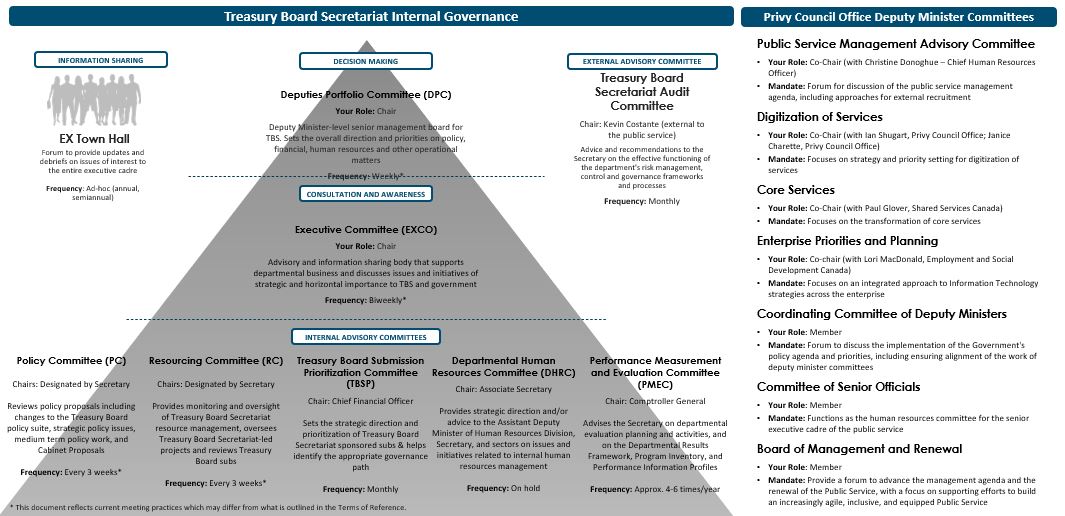
Text version
This infographic shows the committee structure that supports the Treasury Board Secretariat and Privy Council Office Deputy Committees. The infographic shows a pyramid describing the hierarchy of Treasury Board Secretary committees. At the base of the pyramid are the five internal advisory committees: Policy Committee, Resourcing Committee, Treasury Board Submission Prioritization Committee, Departmental Human Resources Committee and Performance Measurement and Evaluation Committee.
The Policy Committee reviews policy proposals including changes to the Treasury Board policy suite, strategic policy issues, medium term policy work, and Cabinet Proposals. It occurs every three weeks
The Resourcing Committee provides monitoring and oversight of Treasury Board Secretariat resource management, oversees Treasury Board Secretariat-led projects and reviews Treasury Board subs. It occurs every three weeks.
The Treasury Board Submission Committee sets the strategic direction and prioritization of Treasury Board Secretariat sponsored subs & helps identify the appropriate governance path. It occurs every month.
The Departmental Human Resources Committee provides strategic direction and/or advice to the Assistant Deputy Minister of Human Resources Division, Secretary, and sectors on issues and initiatives related to internal human resources management. It is currently on hold.
The Performance Measurement and Evaluation Committee advises the Secretary on departmental evaluation planning and activities, and on the Departmental Results Framework, Program Inventory, and Performance Information Profiles. It meets 4-6 times a year.
Above these internal advisory committees sits Executive Committee, which serves in the Consultation and Awareness capacity. It is the advisory and information sharing body that supports departmental business and discusses issues and initiatives of strategic and horizontal importance to TBS and government. It meets biweekly.
Above Executive Committee is the decision-making body, called the Deputies Portfolio Committee, which is the Deputy Minister-level senior management board for Treasury Board Secretariat. It sets the overall direction and priorities on policy, financial, human resources and other operational matters. It meets weekly.
To the left of Deputy Portfolio Committee is the Information Sharing EX Town Hall, which is a forum to updates and debriefs on issues of interest to the entire executive cadre. It meets on an ad-hoc basis.
To the right of Deputy Portfolio Committee is the External Advisory Committee, the Treasury Board Secretarial Audit Committee, which provides advice and recommendations to the Secretary on the effective functioning of the department's risk management, control and governance frameworks and processes. It meets monthly.
Privy Council Office Deputy Minister Committees
Public Service Management Advisory Committee
- Your Role: Co-Chair (with Christine Donoghue – Chief Human Resources Officer)
- Mandate: Forum for discussion of the public service management agenda, including approaches for external recruitment
Digitization of Services
- Your Role: Co-Chair (with Ian Shugart, Privy Council Office; Janice Charette, Privy Council Office)
- Mandate: Focuses on strategy and priority setting for digitization of services
Core Services
- Your Role: Co-Chair (with Paul Glover, Shared Services Canada)
- Mandate: Focuses on the transformation of core services
Enterprise Priorities and Planning
- Your Role: Co-chair (with Lori MacDonald, Employment and Social Development Canada)
- Mandate: Focuses on an integrated approach to Information Technology strategies across the enterprise
Coordinating Committee of Deputy Ministers
- Your Role: Member
- Mandate: Forum to discuss the implementation of the Government's policy agenda and priorities, including ensuring alignment of the work of deputy minister committees
Committee of Senior Officials
- Your Role: Member
- Mandate: Functions as the human resources committee for the senior executive cadre of the public service
Board of Management and Renewal
- Your Role: Member
- Mandate: Provide a forum to advance the management agenda and the renewal of the Public Service, with a focus on supporting efforts to build an increasingly agile, inclusive, and equipped Public Service
Terms of Reference of Deputies Portfolio Committee (DPC)
Mandate
- The Deputies Portfolio Committee will function as the executive management board for the Treasury Board Secretariat. As the key corporate decision-making body, it will set overall direction and priorities on policy, financial, human resources, and other operational matters.
Scope of Activities
- It provides direction and sets priorities related to the issues and initiatives of the highest importance implicating the Treasury Board of Canada Secretariat (TBS). It also monitors the implementation of departmental priorities and ensures a coordinated approach on key issues, and engagement with partners.
- Deputies Portfolio Committee activities include but are not limited to:
- Departmental operational, human resource, and financial decisions (including review of federal budget asks and reallocation decisions);
- Monitoring implementation of departmental priorities and mandate commitments, with a view to timely implementation of key deliverables and to make necessary course corrections; and
- Setting an agenda and ensuring integrated approaches for key Treasury Board Secretariat policy initiatives (e.g., Treasury Board Policy Suite Reset, Medium-Term Planning).
Authorities
- The Deputies Portfolio Committee is the most senior committee with corporate decision-making authority.
- Items brought forward for consideration are considered approved with the endorsement of the Chair.
Relationship to Other Committees
- Executive Committee (EXCO) is both an advisory and information sharing body that supports departmental business. It can provide advice to the Secretary on issues and initiatives of strategic and horizontal importance to the department and government. In most instances, the Executive Committee will also be the final body to review presentations related to departmental priorities or mandate commitments before they leave the department (e.g., Cabinet, Treasury Board, or Deputy Ministers’ Committee presentations). The Deputies Portfolio Committee may request items be brought to the Executive Committee for discussion as required.
- Resourcing Committee (RC) plays a critical role in the monitoring and oversight of financial management within Treasury Board Secretariat, including reviewing quarterly financial statements and the department’s integrated investment and business plan. It oversees Treasury Board Secretariat-led projects at key gates. The Resourcing Committee also reviews major departmental Treasury Board submissions with resource implications, in particular, those referred to by the Treasury Board Submission Prioritization Committee, before they are reviewed by the Government Operations Sector (GOS).
- TB Submission Prioritization Committee (new committee): brings together implicated Assistant Deputy Ministers to agree on the strategic direction and prioritization of Treasury Board Secretariat sponsored submissions. The Committee will advise the Chair of the Resourcing Committee of submissions that require a deeper examination by the Resourcing Committee. The Prioritization Committee will report to the Deputies Portfolio Committee periodically to provide updates.
- Policy Committee is responsible for reviewing Treasury Board Secretariat-led policy proposals. This includes changes to the Treasury Board policy suite, strategic policy issues, medium term policy work, and Cabinet proposals. The Policy Committee supports the Deputies Portfolio Committee by working with sponsoring sectors early-on in the development of major policy initiatives, acting as a sounding board for proposals and helping connect related efforts. As required, the Policy Committee will provide summaries of the considerations of the committee to the Deputies Portfolio Committee and may flag policy issues that require the consideration of the Deputies Portfolio Committee.
- Departmental Human Resources Committee (DHRC) provides strategic direction to the Director General of the Human Resources Division (DG HRD), Secretary, and sectors on issues and initiatives related to internal human resources management, including departmental policies, the departmental human resources plan, recruitment strategies, and talent management, ensuring a consistent approach across the Treasury Board Secretariat. The Departmental Human Resources Committee also reviews key Human Resource (HR) issues before they are presented to the Deputies Portfolio Committee for decision. This would include advice on items such as the Treasury Board Secretariat Human Resources Plan, Human Resources-related strategies (e.g., Analyst Learning and Development, Talent Acquisition), major policy changes, high-risk Human Resources transactions, and other strategic issues, (e.g., Talent Management Approach, etc.). The Chair of the Departmental Human Resources Committee will advise the Director General of Human Resources Division whether items should be referred to the Deputies Portfolio Committee.
- Ad hoc informal committees, created by the Secretary of the Treasury Board, for specific initiatives, may be required to debrief the Deputies Portfolio Committee on their activities, at the discretion of the Chair.
Membership
- The Deputies Portfolio Committee is chaired by the Secretary of the Treasury Board, or his/her delegate.
- Membership comprises the Associate Secretary, the Comptroller General of Canada, the Chief Human Resources Officer, the Chief Information Officer of the Government of Canada, and the Deputy Minister for Public Service Accessibility.
- The Chief Financial Officer, the Senior General Counsel, the Director General of Human Resources, the Assistant Secretary of Strategic Communications and Ministerial Affairs the Assistant Secretary of Priorities and Planning (as Secretary to the Committee), and the Chief Executive Officer of the Canadian Digital Service are ex officio members.
- The Director General of Internal Audit and Evaluation will attend Deputies Portfolio Committee as required.
Meeting Frequency
- The Deputies Portfolio Committee will meet bi-weekly, or as required at the call of the Chair.
Secretariat Support
- The Treasury Board Secretariat’s Committee Secretariat, Priorities and Planning, provides support to the Deputies Portfolio Committee, including: agenda management, advice to the Chair, document distribution, meeting logistics, InfoSite maintenance, tracking and monitoring, and information management.
Terms of Reference of the Executive Committee (EXCO)
Mandate
- The Executive Committee is the key forum for consultation and collaboration on policy and internal management issues.
Scope of Activities
- Provides advice to the Secretary of the Treasury Board on the issues and initiatives of highest strategic and horizontal importance to the Government of Canada and to the Treasury Board of Canada Secretariat (TBS).
- Is informed and consulted on key corporate initiatives and business (e.g., Government of Canada Charitable Workplace Campaign, Public Service Employment Survey results and action plans, financial updates, corporate risk profiles, etc.).
- Receives debriefs on the broad directions and operations of the Treasury Board on a quarterly basis, as well as debriefs from other formal governance committees, as required.
- Undertakes an annual self-assessment of performance, in support of accountability and continuous improvement.
- In most cases, Executive Committee review is required before items are presented to Deputy Minister Committees (the Public Service Management Advisory Committee (PSMAC)), Cabinet Committees or the Treasury Board.
Relationship to Other Committees
The Executive Committee is the main information sharing body for the department’s senior executives. Items will come to it from the Treasury Board Secretariat’s other advisory and decision making bodies including Resourcing Committee, Policy Committee and Deputies Portfolio Committee when required.
- Deputies Portfolio Committee (DPC) members decide what items and decisions made at the senior decision making committee, will be communicated with the Executive Committee.
- Resourcing Committee (RC) plays a critical role in the monitoring and oversight of financial management within Treasury Board Secretariat, including reviewing quarterly financial statements and the department’s integrated investment and business plan. It oversees TBS-led projects at key gates. RC also reviews major departmental Treasury Board submissions with resource implications before they are reviewed by the Government Operations Sector (GOS). As required, the Resourcing Committee will provide updates on the work of the committee to the Executive Committee.
- Policy Committee (PC) is responsible for reviewing Treasury Board Secretariat-led policy proposals, including changes to the Treasury Board policy suite, strategic policy issues, medium term policy work, and Cabinet proposals. For policy proposals proceeding to Public Service Management Advisory Committee or other external bodies, the Policy Committee will consider items before they are shared for information to the Executive Committee. As required, the Policy Committee will provide summaries on the work of the committee to the Executive Committee.
- Departmental Human Resources Committee (DHRC) provides strategic direction to the Director General of the Human Resources Division (DG HRD), Secretary, and sectors on issues and initiatives related to internal human resources management, including departmental policies, the departmental human resources plan, recruitment strategies, and talent management, ensuring a consistent approach across the Treasury Board Secretariat. The Departmental Human Resources Committee also reviews key Human Resource (HR) issues before they are presented to the Deputies Portfolio Committee for decision. This would include advice on items such as the Treasury Board Secretariat Human Resources Plan, Human Resources-related strategies (e.g., Analyst Learning and Development, Talent Acquisition), major policy changes, high-risk Human Resources transactions, and other strategic issues, (e.g., Talent Management Approach, etc.). The Chair will advise the Director General of the Human Resources Division whether items should be referred to the Deputies Portfolio Committee or the Executive Committee.
- Performance Measurement and Evaluation Committee (PMEC) is encouraged to debrief the Executive Committee on its activities.
- Ad hoc informal committees, created by the Secretary of the Treasury Board, for specific initiatives, are encouraged to debrief the Executive Committee on their activities, at the discretion of the Chair.
Membership
- The Executive Committee is chaired by the Secretary of the Treasury Board, or his/her delegate.
- Membership comprises of all Treasury Board Secretariat Deputies, Sector Heads (Assistant Secretaries, Assistant Comptrollers General, Assistant Deputy Ministers), as well as other direct reports to Treasury Board Secretariat Deputies.
- Replacements are permitted only when the member is away for three consecutive days. The Treasury Board Secretariat Committees Secretariat must be advised of any replacements.
Presentation Requirements
- The purpose of Executive Committee engagement must be clear. Presentations to the Executive Committee should also address: risks, financial, and horizontal considerations, as well as outcomes of prior consultations.
- Draft presentation material should be submitted to the Treasury Board Secretariat Committees Secretariat in one official language two weeks prior to the planned Executive Committee meeting date.
- The Treasury Board Secretariat Committees Secretariat will work to review presentation material to ensure appropriate framing of issues and will communicate decision as to whether the item will be considered by the Executive Committee.
- Final presentation material must be submitted to the Treasury Board Secretariat Committees Secretariat in both official languages one week prior to the planned meeting date.
- The Treasury Board Secretariat Committees Secretariat reserves the right to defer items if presentation material is submitted late.
- Presentations (for decision or discussion) are limited to 5-7 minutes to allow up to 25 minutes for discussion.
- Updates (for information) are limited to 10 minutes, including time for questions.
- The Assistant Secretary, Priorities and Planning, reserves the right to circulate information items secretarially rather than allocate time on the agenda.
Official Languages
- Executive Committee meetings are bilingual.
- Debriefs, presentations, and updates must be delivered in both official languages; members may ask questions and presenters may respond to questions in the official language of their choice.
- The Treasury Board Secretariat Committees Secretariat will monitor the extent to which both Official Languages are used and report to the Secretary annually.
Meeting Frequency
- The Executive Committee meets bi-weekly, or as required at the discretion of the Chair.
Secretariat Support
- The Treasury Board Secretariat Committees Secretariat, Priorities and Planning, provides support to the Executive Committee, including: agenda management, advice to the Chair, document distribution, meeting logistics, InfoSite maintenance, tracking and monitoring, and information management.
- The Executive Director, Priorities and Planning, is the Secretary to the Executive Committee.
Backgrounder: The COVID-19 pandemic and the Treasury Board Secretariat
In this section
Executive Summary
The COVID-19 pandemic demanded a rapid pivot for Government of Canada decision makers, departments and agencies. The Treasury Board and Treasury Board Secretariat (TBS) acted to support this pivot and enable government operations, changing how they and the public service functioned. The pandemic pushed the Treasury Board and TBS to streamline decision-making processes and focus more strongly on outcomes. It placed new demands on TBS’ function as an enabling and advice-giving organization, while driving a digital transformation of operations and services, the development of new forms of partnership and mobility, and new challenges to people management in the public service.
As the public service moves towards a new “steady state,” TBS has a role to play in retaining and advancing pandemic-era changes that have made the public service more digital, more flexible and more effective.
To do this, TBS should explore the following opportunities for action:
- Increase TBS’ support for outcomes-based decision making.
- Balance TBS’ role as an oversight and enabling organization, by strengthening its advisory capacity and clarifying departmental authorities.
- Do more to support effective partnerships between federal departments and with other jurisdictions and sectors of society, including in sharing data.
- Strengthen supports for front-line management in the Government of Canada.
- Keep digital and process changes from the pandemic; extend those that require extending.
Scope and Context
This backgrounder focuses on Treasury Board and TBS actions undertaken from the beginning of the pandemic in March 2020 to the spring of 2021, when governments in Canada and around the world began planning for a new “steady state” following the roll-out of vaccines. It does not include later developments, such as the COVID-19 vaccination requirement for federal public servants, nor does it examine planning for a return to federal worksites or a digitally-supported “future of work.”
This work contributes to wider efforts to reflect on the Government of Canada’s pandemic experience, such as audits by the Office of the Auditor General of Canada, whole-of-government work led by the Board of Management and Renewal, and the Management Accountability Framework Adapting in Response to the COVID-19 Pandemic report.Footnote 1
This backgrounder also complements much other work going on across TBS related to specific areas of the TBS mandate. This includes an in-progress study of key Treasury Board policy suite lexibilities supporting the government’s COVID-19 response (hereafter, “Exemptions Report”). The Exemptions Report will examine how to advance greater preparedness for future crises as well as improved Treasury Board and TBS operations outside of the heightened risk environment of the pandemic, and propose future actions TBS could consider to strengthen and adapt the
Treasury Board
policy suite.Footnote 2
Introduction
"Where Treasury Board policies present a barrier to necessary action, Deputy Heads should default to the urgent need."
On 19 March 2020, soon after the World Health Organization declared COVID-19 a global pandemic, the Secretary of the Treasury Board wrote to his senior colleagues to encourage an adaptive and outcomes-focused pandemic response. The Secretary asked Deputy Heads to “focus on achieving the intended results of the Government’s response measures, and to use your sound judgment for maximum flexibility in applying Treasury Board policies and exercising your authorities.”
Recognizing the need for timely action, the Secretary advised that “where Treasury Board policies present a barrier to necessary action, Deputy Heads should default to the urgent need.” The Secretary asked Deputies to document the “circumstances, rationale and processes” of their decisions to support accountability, and added that he had informed the Office of the Auditor General of “the flexible approaches required for departments to be responsive in this crisis”.
The Secretary’s guidance to Deputy Heads both reflects and helped drive a broader change in the federal government during the pandemic.
While federal departments and agencies have always sought to implement the policy objectives of the Government of Canada, internal accountabilities have traditionally placed a greater emphasis on process and administrative compliance than on outcomes. This includes the assessment of risk, in which policy makers have often focused on the risk associated with proposed action rather than the risk of inaction, including risks to social, economic and health outcomes.
This changed with the COVID-19 pandemic. The sheer scale and immediacy of the challenges posed by the pandemic necessitated a focus on outcomes, as can be seen for example in the rapid roll-out of new programs such as the Canada Emergency Response Benefit.
"Urgency and gravity provided federal organizations with the impetus needed to make a significant shift away from a process focus and toward a service mindset."
The Auditor General of Canada observed this change in a March 2021 message, noting the Secretary’s guidance to Deputies and describing a new “service mindset” that “prioritized and focused on outcomes."Footnote 3. This transformation, she wrote, was driven by crisis:
In my view, the urgency and gravity of the pandemic pushed federal organizations in directions they might not have gone of their own accord, nor as quickly. This urgency and gravity provided federal organizations with the impetus needed to make a significant shift away from a process focus and toward a service mindset.Footnote 4
This backgrounder captures key actions of the Treasury Board and the Treasury Board Secretariat (TBS) during the pandemic that demonstrate the shift from process to outcomes. It also identifies opportunities for action for TBS, with the aim of supporting a public service that is more resilient, more flexible and empowered to act in the best interests of Canadians.
The below considers three key areas of TBS action during the pandemic:
- Decision making
- People managment and employee wellbeing
- Digital operations and services*
*During the period covered in this backgrounder (March 2020 to spring 2021), Shared Services Canada (SSC) was included in the portfolio of the Minister of Digital Government, who was also responsible for the Office of the Chief Information Officer (OCIO) and the Canadian Digital Service (CDS) at TBS. With the swearing-in of a new Cabinet on 26 October 2021, SSC was moved to the portfolio of the Minister of Public Services and Procurement, while OCIO and CDS were returned to the portfolio of the President of the Treasury Board.
Decision Making
Actions to support flexible decision making
With the sudden shift to distributed work, the Treasury Board began to meet virtually and on a more flexible, ad-hoc schedule. This allowed the Treasury Board to consider and approve pandemic-related measures on an expedited basis. To support this “virtual” Treasury Board and expedite access to COVID-19-related funding, TBS adopted flexibilities related to Treasury Board submissions, such as permitting electronic signatures and submissions, clarifying classification requirements, and additional format and context-related flexibilities.
To support Treasury Board’s function as the Cabinet committee responsible for approving federal regulations, TBS and the Privy Council Office agreed on an approach to prioritize COVID-19-related regulatory proposals for consideration by the Treasury Board.
Treasury board decision making during the pandemic
During the pandemic, the Treasury Board was faced with a high volume of decisions to be made, related both to COVID-19 and to other government business. [redacted]
In addition, to expedite response efforts and prevent its own policies from unintentionally impeding the government’s COVID-19 response, the Treasury Board delegated to its President a number of authorities that it would normally exercise collectively. Under this new delegation (or “extraordinary authority”), the President could grant departmental requests for exemptions and exceptions to Treasury Board policies and forego the resource-intensive process of developing, submitting and considering a formal Treasury Board submission. This was not a blanket authority: it was time bound, limited in scope and its use was reported to the other members of the Treasury Board.Footnote 5 TBS also made use of existing delegations from the Treasury Board to the President and senior departmental officials to allow for expedited decision making and increase flexibility where appropriate. These flexibilities extended not only to the approval of new programs, but also reduced administrative and reporting burdens to allow departments to focus on the pandemic response.
In addition to these changes, the Treasury Board introduced specific authorities to support flexible decision-making by departments. For instance, on 20 March 2020, the Treasury Board approved temporary amendments to emergency contracting limits, including an unlimited emergency contracting limit for the Minister of Public Services and Procurement for COVID-19 vaccines.Footnote 6
Guidance and advice to support flexible decision making
To support their pandemic response, TBS provided departments with guidance on Treasury Board policy requirements as well as advice on the implementation of new measures, such as the extension of contract limits. In some cases, existing policy instruments still applied, but guidance was necessary to advise departments on how they applied in the pandemic context.
TBS also mobilized government-wide functional communities to provide expertise and assistance. For instance, the Office of the Comptroller General (OCG) encouraged early engagement by departments of Chief Audit Executives and internal audit functions, who were able to advise on how best to document decisions and weigh risks in the light of probable future audits.
During the crisis, departments looked to TBS for much more guidance than is the case in ordinary circumstances. As a result, TBS shifted towards a stronger “advise and support” role than it has traditionally played. These expectations for guidance increased pressure on TBS. The development and provision of guidance is resource intensive, and there are inherent challenges in crafting guidance that is relevant and useful for departments and agencies that vary widely in terms of size and mandate. Given ongoing departmental expectations for guidance, TBS sectors have sought to distinguish between situations when whole-of-government advice from the centre is required and when tailor-made responses led by departments are called for.
Experiences of Departments and Agencies
"The feedback...on these flexibilities was overwhelmingly positive and uniform across departments and agencies."
According to the 2020-21 Management Accountability Framework Adapting in Response to the COVID-19 Pandemic report:
The feedback...on these flexibilities was overwhelmingly positive and uniform across departments and agencies. Most departments and agencies reported that the temporary policy flexibilities were very helpful in obtaining the human and financial resources needed to focus on the COVID-19 pandemic response. Organizations also stated that the temporary policy flexibilities allowed key business processes, such as hiring and onboarding, to continue smoothly during the COVID-19 pandemic.Footnote 7
Similarly, TBS’ Exemptions Report found that “Despite the higher relative risk involved, departments have indicated that these [policy] exemptions and exceptions were crucial for maintaining departmental operations and found that TBS was responsive in putting the exemptions and exceptions in place."Footnote 8 Given the relief afforded by these flexibilities, it is unsurprising that many departments have been eager to see them continue.Footnote 9 More broadly speaking, some have suggested a further simplification of the Treasury Board policy suite. As one department put it in a survey on TBS’ performance in 2019-20:
Overall, our feeling is that there is still value in reducing the 'web of rules' and placing more emphasis on the quality of leadership, management and the consequent results of our people, including both outcomes for citizens and also the way that they affect staff wellness and innovation.… It also means creating more mechanisms for non-compliance with rulesets when they are not in the public interest.Footnote 10
Departments were appreciative of TBS guidance during the pandemic, with some pointing to the positive impact of ongoing calls with functional leaders at TBS. As OCG had advised, some departments integrated their internal audit function into their governance and decision-making processes.Footnote 11 When asked how to improve the implementation of Treasury Board policies and related instruments, departments called for increased access to TBS advice and for increased capacity at TBS to provide that advice.Footnote 12
People Management and Employee Wellbeing
Actions to Support People Management and Wellbeing
As the employer, Treasury Board played an important role in responding to the impacts of COVID-19 on federal personnel. The Treasury Board, its President and TBS undertook a number of actions to support public servants and people management during the pandemic. Perhaps the most significant of these was the President’s 13 March 2020 announcement that public servants should work from home wherever possible. This facilitated a massive shift in the everyday working lives of public servants and the creation, overnight, of a largely distributed federal public service.
Through the Office of the Chief Human Resource Officer (OCHRO), TBS has assisted departments and employees in adapting to this new reality. Over 50 pieces of guidance in areas such as equipping employees remotely, the use of “Other Leave with Pay” (under leave code 699) and performance management in a remote context were issued by OCHRO over the course of the pandemic. OCHRO also developed resources related to mental health challenges for the public service, and put in place temporary measures for public service health care plans, including widening employee access to mental health care. In July 2020, OCHRO also released a guidebook to assist departments in preparing for an eventual return to federal worksites, recognizing that the situation was still in flux.
Responding to the pandemic required new approaches to mobilizing and deploying staff. Public servants volunteered to support new pandemic-related functions, such as call centres, and federal employees were also seconded to assist with provincial and territorial response efforts. This increased mobility was also reflected at TBS, where a number of executives and employees were seconded to the COVID-19 Task Force at Health Canada and the Public Health Agency of Canada.
Managing During a Pandemic
The 2020-21 Management Accountability Framework report found that some departments saw burnout – especially amongst supervisors, managers and executives – as a heightened risk during the pandemic. With the sudden shift to remote work, managers were pushed to adopt new ways to lead their teams, including strengthening their results-based management approach. Learning how to manage remotely required new guidance and resources for managers. A 2020-21 National Managers’ Community survey on learning needs found managers most interested in learning about managing a virtual and flexible team; self-care, setting boundaries, working from home; better communication and engagement within teams and finding effective and safe ways to prevent bullying, intimidation, and favouritism in the workplace; and, how to improve team performance and maintain employee engagement while working from home.Footnote 13 Departments, the National Managers’ Community, and TBS have provided resources to support managers and their wellbeing. TBS is also experimenting with new tools to support managing a distributed workforce, such as time blocking and team charters, which can help articulate shared expectations regarding availability and support a “right to disconnect.”
Talent mobility and surge capacity : TBS staff on the COVID-19 task force
From the beginning of the COVID-19 pandemic, federal departments mobilized talent to support the government’s pandemic response. At TBS, a number of executives and employees were seconded to the COVID-19 Task Force at Health Canada and the Public Health Agency of Canada. There, TBS staff supported a variety of pandemic response measures, including the procurement of personal protective equipment and the development of digital services, such as Get Updates on COVID-19.
Experiences of Departments and Agencies
The sudden shift to distributed work created new opportunities and challenges for people management in the Government of Canada. Distributed work arrangements have offered new flexibilities for employees, though concerns have been raised regarding the impacts of the pandemic and distributed work on mental health. According to the 2020 Public Service Employee Survey, “11% of employees indicated that the stress of the pandemic was negatively impacting their ability to carry out day‑to‑day work responsibilities,” and 21% of employees reported balancing work and caregiving responsibilities during the pandemic as a source of stress. At the same time, 68% of employees saw their workplace as psychologically healthy, up from 61% in 2019.Footnote 14
A number of departments have called for timelier guidance from TBS on people management issues, including on the use of paid leave (under leave code 699) and the provision of equipment for teleworking employees. The development of advice on these types of people management issues was time and resource-intensive; as observed in the Exemptions Report, this process
required engagement with bargaining agents and departmental heads of HR and others. The specificity of guidance needs to recognize the challenge of developing guidance for a very heterogenous public service that was geographically dispersed across the country and hence, across several public health jurisdictions.Footnote 15
Further, as this study notes, “Issuance of clarified guidance in November 2020 [on 699 leave] took time, particularly given the level of rigor, governance, and approvals.”Footnote 16 This suggests the potential value of iterative and ongoing guidance in future crisis situations.
Mental Halth in the Public Service
Approximately 1 in 10 respondents to the 2020 Public Service Employee Survey indicated that the stress of the pandemic was negatively impacting their ability to carry out work responsibilities, while approximately 1 in 5 reported stress caused by trying to balance work and caregiving. At the same time, 68% of respondents see their workplace as psychologically healthy, up from 61% in 2019.
Digital Operations and Services
Actions to support Digital Operations and Services
To support the shift to a “virtual” government created by the pandemic, the Office of the Chief Information Officer (OCIO) at TBS provided whole-of-government leadership to promote the communication of key information related to the pandemic, the effective delivery of digital services and the equipping of departments to maintain operations. OCIO assisted in managing the government’s legislative and policy responsibilities by providing guidance related to Access to Information and personal information requests, proactive publication and information management.
"Since March 2020, SSC increased SRA [secure remote access] capacity by 111% to support 290,000 simultaneous connections. As a result, public servants were able to continue delivering services to Canadians and maintain operations following the work from home order."
In response to the pandemic, the Government of Canada accelerated a digital shift previously underway that enabled continuity of government operations and of services to the public. OCIO and Shared Services Canada (SSC) worked together to strengthen and expand the Government of Canada’s network capacity and introduced tools, including Microsoft Teams, which supported distributed and collaborative work by public servants. The transition to distributed work also required that SSC increase the bandwidth and IT support structure to ensure that the government’s digital infrastructure could support a high volume of internet traffic. OCIO and SSC also worked closely to support departments on the front-line of the pandemic response, such as the Canada Revenue Agency and Employment and Social Development Canada, to ensure that the critical services offered by these departments were supported by reliable, secure IT infrastructure.
TBS leveraged internal and external relationships to support government-wide initiatives and deliver expedited results. For example, TBS collaborated across the federal government, with other Canadian jurisdictions and sectors, and across national borders, to establish a coordinated digital response to COVID-19. The Canadian Digital Service (CDS) worked with private sector partners, as well as provincial and territorial jurisdictions, to design, repurpose, and deliver products and services including the COVID Alert exposure notification app, which was launched using open-source code.
CDS worked with Health Canada and the Public Health Agency of Canada to help introduce a new notification service called “Get Updates on COVID-19,” which was built using open-source code from the U.K. Digital Service. This work was also led by TBS employees on secondment to Health Canada. This email notification system provides updates and pertinent information to millions of people in Canada on a regular basis. This tool is, by design, easily scalable and has been adopted by other governments across Canada.
TBS also worked closely with digital partners and engaged with federal departments and agencies to accelerate publication and improve the usability and discoverability of open data and open information related to COVID-19 to support greater transparency.
Federal Microsoft Teams Rollout
With the overnight transition to distributed work, public servants made creative use of digital tools such as Slack and videoconferencing to maintain contact and business continuity. These tools were an important stopgap measure that were soon replaced by the rapid rollout of Microsoft Teams. SSC deployed Microsoft Teams to 40 departments and 290,000 employees in the Government of Canada. In addition, SSC provided additional teleconference licences, leading to a more than 200% increase in teleconference usage. Federal public servants have also increased their use of WebEx accounts by 100%.
Experiences of Departments and Agencies
The transition to distributed work significantly increased the need for and demands on network capacity and collaborative tools. OCIO and SSC played a significant role in supporting operational continuity and the shift to a distributed workforce. In interviews conducted to support the 2020-21 Management Accountability Framework assessment, “The support SSC provided to its GC partner organizations was the most frequently cited enabling factor to overcoming challenges departments and agencies faced as a result of the COVID-19 pandemic and the immediate need to move to a remote workforce."Footnote 18
The rollout of Microsoft Teams was foundational to supporting a new digital workspace for public servants. Microsoft Teams enabled increased engagement with employees in fora such as digital town halls; it was used by departments to support hiring practices, onboarding and training, and sessions on mental health. Microsoft Teams also allowed for closer communication with regional employees. One department noted that the pre-pandemic adoption of Microsoft Teams had smoothed its transition to a distributed workforce, and departments that had already invested in and embraced a “digital first” mindset and related tools found it often made the transition more straightforward.
The shift to distributed work meant many employees did not have access to the Secret Network. In some cases, this led to documents being correctly reclassified as not secret and dealt with on the normal network, but in other cases this limited the ability of departments to deal with secret material. While OCIO worked with SSC and functional communities to develop guidance on how to appropriately manage classified information while working remotely, some departments reported risk-managing the “safe handling of sensitive and secret information” while awaiting guidance from TBS.Footnote 19
Departments have raised concerns regarding barriers to sharing data between federal departments and agencies, across jurisdictions and with other key stakeholders. Even when data is shared, there are challenges regarding interoperability and standardization, as well as a lack of understanding as to what data exists or is being collected by different levels of government. Some federal departments, including Statistics Canada, are supporting data communities of practice. Others have recommended that the government invest in enabling platforms to allow for the exchange of data across the public service.
The Experience Elsewhere: Other Jurisdictions
The experiences at TBS were largely reflected in other sectors and jurisdictions. The COVID-19 pandemic caused or accelerated significant changes in government operations worldwide. From remote work to digital transformation, Canadian and foreign governments, as well as organizations in other sectors, have re-engineered their structures, tools and processes to respond to the ongoing crisis. Many jurisdictions adopted remote work to support business continuity, employee health and respect for public health guidelines. The crisis also sparked an increased need for surge capacity and employee mobility. Peer countries such as the United States instituted rotational opportunities related to the COVID-19 pandemic, and Australia developed a multi-jurisdictional National Framework for Public Sector Mobility and is considering the establishment of a permanent “surge reserve” for civil servants.
The pandemic also revealed that governments can shift to digital service formats when emergencies drive necessity. From deploying new social programs to creating virtual parliaments and virtual courts of justice, the pandemic caused governments to accelerate digital transformation. As noted in a case study by the Public Policy Forum, Ontario’s Minister of the Attorney General shifted quickly from a dependence on in-person and paper-based processes to a digital environment. One official suggested that the change imposed on the Ministry by the pandemic actually allowed public servants to overcome the low risk tolerance, slow approvals and the tendency to seek largescale “ultimate” solutions that had previously plagued efforts to digitize.Footnote 20
Finally, in the areas of expenditure management and procurement, governments were pushed to deliver new programs and services in an expedited manner while also ensuring financial transparency and accountability to their citizens. Many countries exercised increased fiscal flexibility by granting new spending powers to the executive; the Portuguese parliament, for example, granted the Portuguese government that power to “transfer appropriations across programmes within the budget."Footnote 21 Additionally, jurisdictions relaxed and streamlined rules to facilitate rapid procurement while ensuring the use of public resources remained transparent and linked to results.
As at TBS, the experience elsewhere shows governments and organizations of all stripes exercising new flexibilities and adapting to the pandemic by quickly mobilizing resources – human, digital and financial – to respond to the new emergency context. A similar willingness to temporarily streamline processes in favour of achieving outcomes in the short-term is also evident.
Conclusion
The Covid-19 pandemic required governments to pivot and adapt in order to best respond to the crisis.
TBS, and the broader public service, were no exceptions to this rule. The flexibilities, guidance and hands-on support provided by TBS helped departments focus their efforts on the pandemic and protect and support the public. The experience also suggests several opportunities for action for TBS as it continues to support the public service in future challenges. TBS should aim to:
- Increase its support for outcomes-based decision making.
- Balance its role as an oversight and enabling organization, by strengthening its advisory capacity and clarifying departmental authorities.
- Do more to support effective partnerships between federal departments and with other jurisdictions and sectors of society, including in sharing data.
- Strengthen supports for front-line management in the Government of Canada.
- Keep digital and process changes from the pandemic; extend those that require extending.
1. Increase TBS' support for outcomes-based decision making.
Decision making in large organizations can sometimes be skewed by the habit of looking to pre-existing levers and processes and allowing these to determine outcomes, rather than focusing on desired outcomes and determining how best to achieve them. While progress has been made at TBS to become more principles-based and focused on outcomes rather than process, more can be done by TBS to support outcomes-based decision making. Departments should be held accountable for what they achieve or fail to achieve.
TBS should continue efforts to reframe government rulesets to encourage outcomes-based decision making, as well as revising TBS-imposed forms of oversight and process that impede departmental efforts to be more creative, innovative and agile. This could include, as proposed in the Exemptions Report, a focus on risk- and results-based information requirements placed by TBS on departments.Footnote 22
Supporting outcomes-based decision making should also include learning from the government’s experience with risk management and mitigation during the pandemic, including how to make processes and oversight lighter and provide departments with more flexibility, when appropriate and within a framework of responsible controls.
2. Balance TBS' role as an oversight and enabling organization, by strengthening its advisory capacity and clarifying departmental authorities.
During the pandemic, TBS has continued its oversight function but has also focused on responding to departmental requests for advice and guidance. The extent to which departments have turned to TBS for support demonstrates that this enabling role is as – and perhaps more – important to the federal system as TBS’ traditional challenge function role. Offering timely, applicable and expert advice is resource intensive, which TBS will have to take into account in the development of its plans and priorities as a department.
"It would be useful … to identify clear boundaries between the roles and responsibilities of the TBS and that of departments and agencies in the development and implementation of projects, programs and policies."
COVID-19 also highlighted that departments need more clarity on areas in which they have the authorities to act, and when they need to wait for central agency guidance. Greater clarity around delegated authorities for departments implies not only an emphasis on departmental responsibilities but also the need for TBS to accept that departments will sometimes make unexpected choices and that those choices should be respected if they fall within the broader frame set out by Cabinet and the Treasury Board.
3. Do more to support effective partnerships between federal departments and with other jurisdictions and sectors of society, including in sharing data.
Canada’s response to COVID-19 has required extensive collaboration between federal departments, jurisdictions and other sectors of society, such as the private sector, academia and non-governmental organizations. Within government, TBS could do more to support effective and intensive interdepartmental collaboration, including through enabling secure data sharing and standardization as well as effective governance.
Stronger external partnerships, including government-to-government relationships and digital partnerships, could also help in addressing future problems. Open-source code enabled the rapid deployment of digital solutions, including the COVID Alert app and the “Get Updates on COVID-19” e-mail notification service. The Government of Canada can continue to build upon open-source code and “work in the open” by publishing code from its own products where possible. In supporting the Treasury Board’s role as employer of the public service, TBS could encourage greater permeability between the public service and external organizations (e.g. through talent mobility), which would help ensure that the Government of Canada has the capacities required to respond to future crises.
4. Strengthen supports for front-line management in the Government of Canada.
COVID-19 and the transition to widespread distributed work has increased the pressure on front-line managers. Management of a distributed team requires managers to adapt and adjust, and TBS has a role to play in better supporting managers and improving the quality of management skills and training, along with partners across the public service.
5. Keep digital and process changes from the pandemic; extend those that require extending.
Many flexibilities have been introduced during the pandemic to permit the use of new digital tools and approaches (e.g. digital signatures and approvals, electronic submission of Treasury Board submissions). TBS should work to solidify and extend those flexibilities, where appropriate. Equipping public servants with the tools to work from home has also offered new flexibilities to employees and has removed significant barriers for some employees with disabilities. TBS should support departments in consolidating and building upon gains made through the “forced experiment” of widespread distributed work.
New challenges will no doubt emerge in the years to come. The more TBS can do to support and enable departments, helping them focus on and deliver concrete outcomes while ensuring that the appropriate controls are in place and risks are managed, the better prepared the public service will be for those future challenges.
Workplan status update: Treasury Board Secretariat’s hybrid workplace
In this section
- Presentation Objectives
- Enterprise-Wide Context
- Treasury Board Secretariat’s current work environment
- Planning for a future hybrid work environment
- Short- and medium-term actions
- Considerations
- Next steps
- Annex A: Progress against the Treasury Board Secretariat Hybrid Workforce Plan
- Annex B: Governance
Presentation Objectives
Provide an overview of the Treasury Board of Canada Secretariat’s (TBS) departmental approach to hybrid work including work to-date and the path forward
Enterprise-Wide Context
- As the federal employer, the Treasury Board Secretariat is continuing work on the future of work and post-pandemic planning with key partners (e.g., Privy Council Office, Public Services and Procurement Canada, Shared Services Canada)
- The Chief Human Resources Officer has provided departments guidance for an optimal hybrid workplace to ensure a consistent and coherent approach
- All departments, including the Treasury Board Secretariat, have been encouraged to filter their plans through the following core principles:
Principles to Guide Departmental Hybrid Workplans Across Government
Flexibility
Openness to exploring and experimenting with different approaches to work
Arrangements
A foundational practice, including flexibility in work locations (where operationally feasible)
Transparency
How decisions are made and communicated
Equity
Ensuring employees are treated fairly in decisions, with a view to creating diverse and inclusive workplaces
Excellence
Underpinning the design and delivery of public sector policy, programs and services
Treasury Board Secretariat’s current work environment

The majority of Treasury Board Secretariat employees have been operating under “remote by default” in response to the COVID-19 pandemic since March 2020

Work is underway to understand Treasury Board Secretariat’s hybrid work context including:
- Operational requirements
- Evolving needs and demands on office space and IT
- Human element (e.g., needs and supports to be productive and outcomes focused regardless of role / level / personal circumstances)

Collectively these elements can provide Treasury Board Secretariat’s Deputies with evidence to support the path forward
Key Facts on Current Status
- All Treasury Board Secretariat employees are fully equipped to work remotely
- Worksite capacity is significantly lower than the Treasury Board Secretariat’s staff complement (1591 worksites vs. 2276 employees) due to social distancing requirements
- 95% of staff working from home by default; onsite workstation bookings remain extremely low
- Some executives have reported on reasons their employees may work on site, and include
- Operational requirements (e.g., access to data bases, the secret network, critical work and deadlines, on-site interactions)
- Personal reasons
- A home environment that is not secure or conducive to working
- Secret network access and onsite bandwidth are not yet ready to support a fully hybrid workforce
Planning for a future hybrid work environment
The Treasury Board Secretariat’s plan takes a phased approach to supporting a long-term hybrid work environment*
Pandemic phase / controlled

Where we started
March 2020
Gradual shift to on-site
Conditional on public health restrictions

Short-term
Fall 2021 / Winter 2022
Engagement and Assessment Phase

Medium term
Spring 2022
Optimized Hybrid Model Implementation

Long term
Fall 2022 and beyond
In addition to the Office of the Chief Human Resources Officer-issued guidance, the plan is underpinned by:

Treasury Board Secretariat’s Easing of Restrictions Plan
- Work done in Summer 2020
- Committed to protecting employee health and safety; respecting public health measures; consulting employees; flexibility and iteration

Data collection
- Data collection from the Treasury Board Secretariat office booking system will provide insights into when and how the worksite is being used
- Use of an Employee Status Reporting Tool seen as a best practice to support health and safety

Departmental Governance**
- Governance is in place to guide the work
- Assistant Deputy Ministers committee co-chaired by the heads of Human Resources liision and Corporate Services Sector
- Recommendations made to the Deputy Portfolio Committee
*Details of progress made against each element included in Annex A
**Further details on governance included as Annex B
Short- and medium-term actions
Work is underway to…
Determine how to best prepare the department operationally for a post- pandemic context*
- Assess operational requirements: Examine position duties, accountabilities, and responsibilities
- Determine infrastructure requirements: Assess Information Technology capacity to support a hybrid workforce
- Engage employees: Potentially through workshops, surveys, and interviews to inform opportunities and challenges in an evolving environment. This includes staff, managers, and senior officials
*The original document provided to the Secretary contained an asterisk at this point corresponding to a note stating “See Annex C.” However, the original document did not contain an Annex C. Therefore, for the publication version, we have omitted the note.”
Work will need to be done to…
- Review internal policies for flexibilities to facilitate the hybrid model
- Determine the optimal hybrid model for the Treasury Board Secretariat that leaves flexibility between sectors
- Update Information Technology capacity and invest in workspace and building redesign
Work is ongoing to…
- Provide executives guidance for managing in a hybrid environment as public health measures evolve
Considerations
- Progress towards a post-pandemic work environment may not be linear
- Health guidelines are ever-evolving and this plan may need to be revised given ongoing uncertainty
- Opportunity to sequence, test ideas, seek reactions and determine feasibility
- Regular communication from leaders at all levels can serve to decrease uncertainty
- Treasury Board Secretariat’s plan is gradual and iterative; it is positioned to:
- Provide a framework to managers and employees to continue being productive in delivering the Treasury Board Secretariat mandate
- Consider what employees need to support their mental health and avoid burnout amidst constant changes
- Align to the enterprise-wide direction on people management
- Support a competitive advantage for recruitment, retention and development
- Focus on good implementation and allow for course corrections and flexibility
- The department is working with other departments (OGDs)
- Engaging with other departments, including the Privy Council Office and Finance Canada, on lessons learned and ensuring the Treasury Board Secretariat takes a balanced approach given its Central Agency role
- Working with Public Services and Procurement Canada to explore opportunities to condense Treasury Board Secretariat real estate and prepare for the future workplace
- Engaging with co-tenants, in particular Finance, to coordinate approaches and share best practices
- Returning too quickly to the workplace, without the right enabling environment, may impact productivity and mandate delivery
- Circumstances remain unpredictable (e.g. impacts of new variants)
- Real risk of burnout which could be exacerbated by sudden even small changes to the work environment
- Gender Based Analysis+ considerations must be closely examined
- Employees will need time to adjust to any changes and make necessary arrangements such as childcare, having children vaccinated, and transportation
- At-risk, vulnerable employees may need accommodation, as well as employees with young children not eligible for vaccination
- Partnerships with Bargaining Agents will help inform the process
Next steps

Governance
The Assistant Deputy Ministers Committee will be briefing the Deputies Portfolio Committee regularly on this plan

Engagement
Planning for employee engagement and assessment of operational requirements will continue
Annex A: Progress against the Treasury Board Secretariat Hybrid Workforce Plan
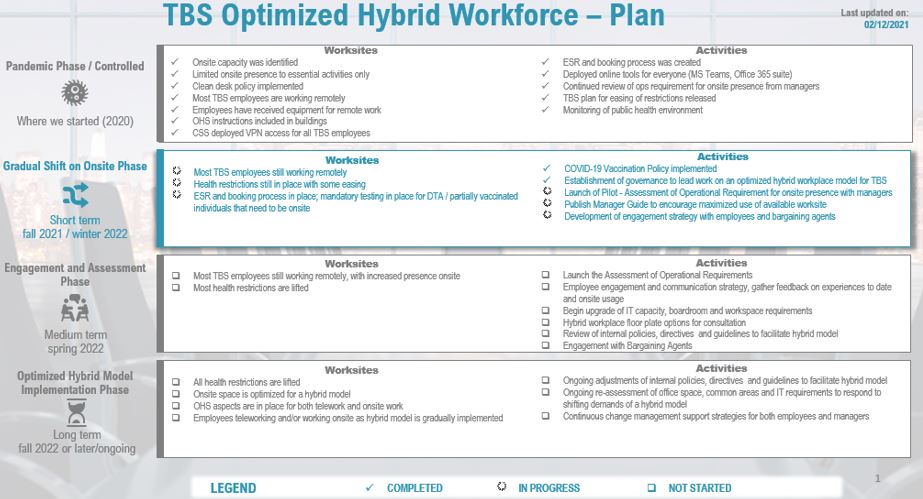
Text version
TBS’ plan for an optimized hybrid workforce. The plan shows the status of TBS worksites during each phase of the plan as well as activities undertaken as part of the plan. Plan items are identified as “completed,” “in progress” or “not started.” The plan indicates that we are currently in the “Gradual Shift on Onsite – Short Term” phase, with a time frame of fall 2021/winter 2022. The plan was last updated on December 2, 2021.
| Plan phase | Worksites | Activities |
|---|---|---|
| Pandemic Phase/Controlled – Where we started (2020) |
|
|
| Gradual Shift on Onsite Phase – Short term (fall 2021 / winter 2022) |
|
|
| Engagement and Assessment Phase – Medium term (spring 2022) |
|
|
| Optimized Hybrid Model Implementation Phase – Long Term (fall 2020 or later/ongoing) |
|
|
Annex B: Governance
- The Deputies Portfolio Committee (DPC) is the ultimate deciding committee for all reintegration and hybrid workplace plans for the Treasury Board Secretariat
- The Assistant Deputy Ministers Committee, called the Optimized Hybrid Workplace Modernization Centre, is co-chaired by Human Resources and Corporate Services
- It is responsible for:
- Providing prompt advice to the Deputies Portfolio Committee on the optimized hybrid model for the Treasury Board Secretariat, including considerations such as capacity, health measures, etc.
- Providing direction to the associated Optimized Hybrid Workplace Working Group, as well as approving and challenging recommendations provided by the Working Group
- Supported by a number of other players in the department, including Priorities & Planning, Strategic Communications and Ministerial Affairs, Office of the Chief Human Resources Officer, etc. to ensure that key perspectives are captured
Treasury Board of Canada Secretariat: Financial Overview
In this section
Purpose
Overview
Provide an overview of the operating vote and central votes of the Treasury Board of Canada Secretariat (TBS)
Financial overview: Treasury Board Secretariat operating budget 2021–22
- The Treasury Board Secretariat has an approved operating budget of $324.9 million in 2021–22, of which $228 million (70%) is for salary and $96.9 million (30%) is for goods and services.
- For 2021–22, 28% of the Treasury Board Secretariat’s Vote 1 funding envelope comprises temporary funding; another $36 million is recovered from other government departments through Memoranda of Understanding.
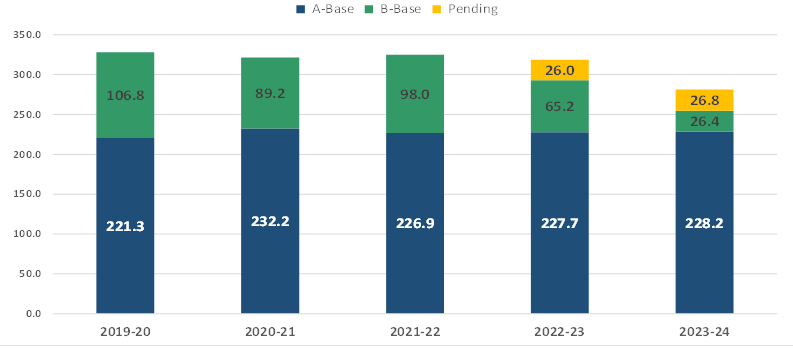
Text version
| Year | A-Base | B-Base | Pending |
|---|---|---|---|
| 2019–20 | $221.3 million | $106.8 million | |
| 2020–21 | $232.2 million | $89.2 million | |
| 2021–22 | $226.9 million | $98.0 million | |
| 2022–23 | $226.9 million | $65.2 million | $26.0 million |
| 2023–24 | $228.2 million | $26.4 million | $26.8 million |
Note: “Pending” refers to items for which funding is earmarked in the Fiscal Framework, but the funding has not yet been accessed via a Treasury Board submission.
Financial overview: initiatives with temporary funding
- The Treasury Board Secretariat has 14 initiatives with temporary funding that will end in the next three years that have 272 Full-time Equivalents (FTEs) and funding of $66 million.
Initiatives with temporary funding in Treasury Board Secretariat Vote 1, with funding ending after…
2022–23 (201 FTEs, $42.6 million)
- HR-to-Pay / Pay Stabilization (96 FTEs, $21.3 million)
- COVID-19 Vaccination Policy Implementation (28 FTEs, $5.4 million)
- Classification Program (25 FTEs, $4.5 million)
- Official Languages Modernization (23 FTEs, $4.2 million)
- Centre on Diversity and Inclusion (14 FTEs, $4.4 million)
- Regulatory Reviews (15 FTEs, $2.8 million)
2023–24 (39 FTEs, $9.2 million)
- Office of Public Service Accessibility (17 FTEs, $3.1 million) and Centralized Enabling Workplace Fund (2 FTEs, $1.3 million)
- Access to Information Action Plan (11 FTEs, $2.9 million)
- Centre of Expertise on Real Property (4 FTEs, $1.2 million)
- E-Payroll (3 FTEs, $0.4 million)
- Advancing Gender Equality / Women’s Program (2 FTEs, $0.3 million)
2024–25 (32 FTEs, $14.2 million)
- Pay Equity Administration and Machinery (26 FTEs, $13.1 million)
- Indigenous Procurement Strategy (4 FTEs, $0.6 million)
- Federal Contaminated Sites Action Plan – Phase IV (2 FTEs, $0.5 million)
- Some of these initiatives may be required to operate beyond their existing funding profiles, depending on government priorities and Cabinet decisions. The Treasury Board Secretariat may need to submit funding proposals to seek renewed funds.
Financial overview: Vote 20 and other central votes
- The Corporate Services Sector provides oversight of Treasury Board Secretariat Vote 1 and Vote 20.
- Vote 20 is a quasi-statutory vote managed by the Office of the Chief Human Resources Officer and is used to pay the
employer’s share of group benefit plan coverage costs as part of the Treasury Board’s role as the employer
of the core public administration.
- The Treasury Board Secretariat regularly seeks incremental funding for Vote 20 to address price and volume increases and to offset any operating fund deficits in the group benefit plans.
- The other central votes are managed by the Expenditure Management Sector. Funding in the other central votes is transferred from the Treasury Board Secretariat to individual departments and agencies once specified criteria are met.
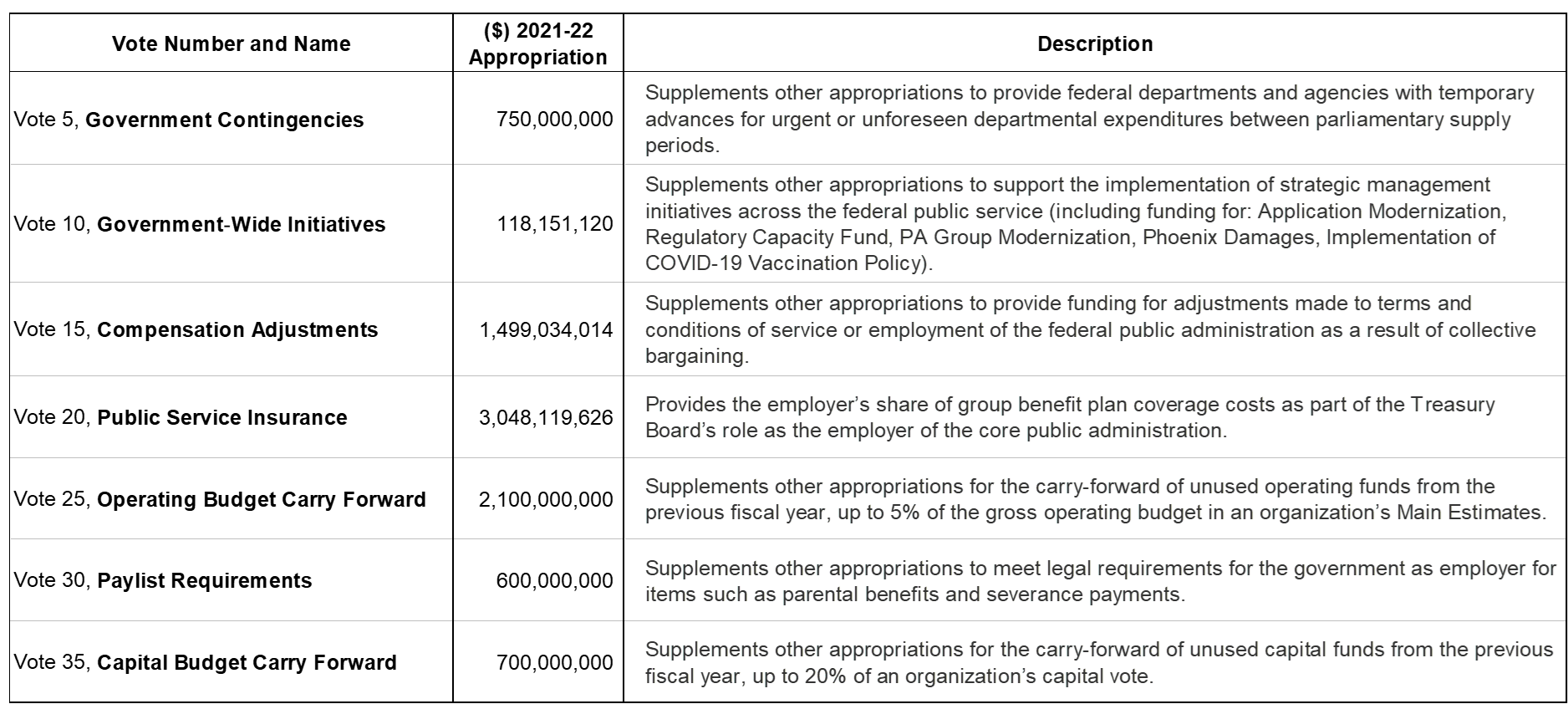
Text version
A table showing TBS central votes, the amount (in dollars) appropriated in 2021-22 for each vote, and a description of each vote.
| Vote number and name | ($) 2021-22 Appropriation | Description |
|---|---|---|
| Vote 5, Government Contingencies. | 750,000,000 | Supplements other appropriations to provide federal departments and agencies with temporary advances for urgent or unforeseen departmental expenditures between parliamentary supply periods. |
| Vote 10, Government-wide Initiatives | 118,151,120 | Supplements other appropriations to support the implementation of strategic management initiatives across the public service (including funding for: Application Modernization, Regulatory Capacity Fund, PA Group Modernization, Phoenix Damages, Implementation of COVID-19 Vaccination Policy). |
| Vote 15, Compensation Adjustments | 1,499,034,014 | Supplements other appropriations to provide funding for adjustments made to terms and conditions of service or employment of the federal public administration as a result of collective bargaining. |
| Vote 20, Public Service Insurance | 3,048,119,626 | Provides the employer’s share of group benefit plan coverage costs as part of the Treasury Board’s role as the employer of the core public administration. |
| Vote 25, Operating Budget Carry-Forward | 2,100,000,000 | Supplements other appropriations for the carry-forward of unused operations funds from the previous fiscal year, up to 5 % of the gross operating budget in an organization’s Main Estimates. |
| Vote 30, Paylist Requirements | 600,000,000 | Supplements other appropriations to meet legal requirements for the government as employer for items such as parental benefits and severance payments. |
| Vote 35, Capital Budget Carry Forward | 700,000,000 | Supplements other appropriations for the carry-forward of unused capital funds from the previous fiscal year, up to 20% of an organization’s capital vote. |
Summary of Hot Issues, [redacted]
Summary of Hot Issues Across the Treasury Board Secretariat
| Item | Action Required | Deadline |
|---|---|---|
| Renewal of 16 audit committee members in 13 departments |
|
February 2022 |
| [redacted] | [redacted] | [redacted] |
| Developing the Directive on the Stewardship of Financial Management Systems |
|
By March 31, 2022 |
| Publishing the President of the Treasury Board’s Fees Report for the 2020-21 Fiscal Year, as required by the Service Fees Act |
|
By March 31, 2022 |
| Item | Action Required | Deadline |
|---|---|---|
| [redacted] | [redacted] | [redacted] |
| Advancing Canada-US regulatory cooperation | Meeting with the Acting Director of the US Office of Management and Budget to solidify the path forward | Earliest convenience / contingent upon Senate Confirmation hearings |
| Chair ad hoc Deputy Minister committee meeting on regulatory modernization | Call next meeting to advance priorities on Regulatory Modernization | TBD (January-February 2022) |
| Tabling of 2nd Annual Regulatory Modernization Bill (ARMB) | Support to the President in leading the bill through Parliament | TBD (early to mid 2022) |
| [redacted] | [redacted] | [redacted] |
| Initiate Round 3 of Targeted Regulatory Reviews | Approval of topics for Round 3 and launch review with support of implicated departments | TBD (dependant upon interdepartmental consultations, underway) |
| Item | Action Required | Deadline |
|---|---|---|
| Mandatory vaccination in the Public Service |
|
Winter 2022 [redacted] |
| Total compensation and collective bargaining |
|
[redacted] |
| NextGen HR and Pay Solution |
|
Winter 2022 |
| Modernization of the Official Languages Act |
|
February 2022 |
| Senior Leaders Strategy |
|
January 2022 March 2022 |
| [redacted] | [redacted] | [redacted] |
| 2022 benefit plan premium rate update |
|
By January 15, 2022 |
| Phoenix Litigation |
|
January 2022 |
| Pay equity implementation |
|
Spring 2022 and ongoing |
| Re-appointment of the Public Sector Integrity Commissioner (PSIC) |
|
The re-appointment must be approved by both Houses and complete by March 26, 2022. |
| Item | Action Required | Deadline |
|---|---|---|
| Direction on the President’s 2021 mandate commitments | Direction | January 2022 |
| Treasury Board Secretariat 2022-23 Departmental Plan | Approval (President sign-off required) | January 2022 |
| Supplementary Information to the Departmental Plan – publication to the Treasury Board Secretariat Website | Approval of information on work at TBS related to gender-based analysis plus, sustainable development and TBS’s transfer payment programs | February 2022 |
| Management Accountability Framework Government-wide and Departmental Reports | Approval | April 29, 2022 |
| Office of the Auditor General Audit on Human Ressources Management (Tabling in March 2022) | Signature | February 2022 |
| Office of the Auditor General Audit on Gender Based Analysis Plus (Tabling in March 2022) | Signature | February 2022 |
| Office of the Auditor General Audit Plan Summary – Benefits Delivery Modernization | Signature | February 2022 |
| Office of the Auditor General Audit on Greening Government (Tabling in April 2022) | Signature | February/March 2022 |
| Item | Action Required | Deadline |
|---|---|---|
| Tabling of Supplementary Estimates (C) and Main Estimates | Support the President’s appearance before Parliamentary Committee in respect of the Estimates | Tabling Date: February 2022 Committee appearance: March 2022 |
| (Mandate Letter) Ensure government policy is developed through an intersectional lens by strengthening the quality of life framework, gender-based analysis plus, and integrated climate lenses | Provide advice to President | Winter 2022 |
| (Mandate letter) Conduct comprehensive and continuous strategic policy review of government programs | Provide advice to President | Winter 2022 |
| Item | Action Required | Deadline |
|---|---|---|
| Broad Financial Situation |
|
Ongoing discussion |
| Addressing priorities related to COVID-19 |
|
Ongoing; expected Winter 2022 |
| Delegation of Spending and Financial Authorities |
|
January 2022 |
| Sustainable Cloud Funding |
|
1 April 2022 |
| Support to Treasury Board |
|
Ongoing |
| Co-lead the Budget 2022 process with Priorities & Planning |
|
January 2022 |
| Item | Action Required | Deadline |
|---|---|---|
| Access to Information (ATI) Review | The Government committed to a full review of the access to information process and to holding a broad engagement process during the review, including engagement with the general public, Indigenous groups and representatives, federal institutions and other consultation activities. [redacted] | [redacted] |
| National Security and Intelligence Committee of Parliamentarians (NSICOP) Report 2021 |
|
February 2022 |
| Item | Action Required | Deadline |
|---|---|---|
| Access to Information Act (Legislative review and ongoing requests) | Communicate the outcome of the review and ongoing issues management | Ongoing |
| Collective Bargaining | Issues management, strategic pivot to proactive communications stance as needed | Ongoing |
| Vaccination policy public reporting & litigation | Entreprise coordination of public reporting & issues management | Ongoing |
| Easing restrictions at federal worksites | Entreprise coordination of internal communications & issues management | Ongoing |
| Return to secure posture (Treasury Board & Cabinet) | Manage ongoing operational issues & establish future steady state | Q4 2022 |
| Harassement & discrimination lawsuits (e.g. Thompson & Diallo) | Communications coordination with implicated depts & issues management | Ongoing |
| Appearance for Supplementary Estimates C (TBC) | N/A | February/March |
| Item | Action Required | Deadline |
|---|---|---|
|
Policy on COVID-19 Vaccination |
Status update on:
|
None |
|
Treasury Board Secretariat Hybrid workplace |
Departmental Updates through Deputies Portfolio Committee |
No immediate action |
| Item | Action Required | Deadline |
|---|---|---|
| [redacted] | ||
| Item | Action Required | Deadline |
|---|---|---|
| The future of the COVID Alert exposure notification app | A decision is needed on the future of the COVID Alert exposure notification service, which is owned by Health Canada and operated by the Canadian Digital Service. Targeted programmatic funding provided to the Canadian Digital Service to support the initiative sunsets in March 2022. If the service is to remain operational, additional federal investment will be required to keep it operational, accessible and secure. | January 2022 |
| Canadian Digital Service Chief Executive Officer Recruitment | Canadian Digital Service has been without a permanent CEO since September 2021. Recruitment materials have been prepared in consultation with Treasury Board Secretariat's Human Resources Division. Approval is required for the materials and to launch the public recruitment process. | January 2022 |
| Item | Action Required | Deadline |
|---|---|---|
| Publishing the Internal Audit of Acquisition Cards | N/A. Memo to President for information prepared. | By January 31, 2022 |
[redacted]
[redacted]
Planned reports of the Office of the Auditor General and the Commissioner of the Environment and Sustainable Development
Auditor General of Canada Reports
Spring 2022
- Management of Government Human Resources*
- Gender-Based Analysis Plus*
- Systemic Barriers in Correctional Services
- Disability Benefits for Veterans and their Survivors
Fall 2022
- Cybersecurity of Personal Information in the Cloud*
- Protecting the North
- Benefits Delivery Modernization*
- Chronic Homelessness in Canada
- Preparedness for Emergencies in Indigenous Communities
- Vaccine Expenditures
- Post-Payment Verification under the Canada Emergency Response Benefit and the Canada Emergency Wage Subsidy
* TBS currently implicated
Commissioner of the Environment and Sustainable Development Reports
Spring 2022
- Greening Government Strategy*
- Hydrogen in Canada’s Energy System
- Climate Resilient Infrastructure
- Study on Reporting Climate Change Information
- Just Transition
- Federal Carbon Pricing Benchmark
Fall 2022
- Protecting Aquatic Species at Risk
- Nuclear Waste Management
- Environmental Petitions Annual Report
- Federal Sustainable Development Strategies
Overview of the Treasury Board Policy Suite Changes
November 2021
In this section
- Treasury Board sets the rules for how government is managed
- Treasury Board Policy Suite represents the Government’s administrative policies and the scope and the scale of the government activity.
- Treasury Board policies have significant impact and guide all aspects of Government of Canada operations
- During the past seven years, the Treasury Board Policy Suite was reset
- Through Treasury Board Policy Suite Reset, the approach to policy has evolved
- A Responsive Treasury Board Policy Suite: Enabling Departments’ Crisis Response to COVID-19
- Beyond Treasury Board Policy Suite Reset
Treasury Board sets the rules for how government is managed
The Financial Administration Act (FAA) gives Treasury Board (TB) the authority on matters related to the general administrative policy in the federal public administration
Treasury Board’s mandate is to ensure that the federal public service is managed coherently and effectively by:
- Outlining how Deputy Heads and Ministers exercise their authorities and manage public resources
- Establishing management policies that cover functional areas such as Official Languages, Human Resources, Financial Management, Information Management and Information Technology, Acquired Services and Assets, and others
- The Treasury Board Policy Suite is the set of rules for management in the federal public service, ensuring that government resources are effectively managed, while demonstrating care and good judgement, and to manage significant risks to the operations of government
- The Treasury Board Policy Suite is unique as it is comprehensively determined by Treasury Board, which acts as the central management board – this is in contrast to other Westminster jurisdictions where greater organizational autonomy is permitted
- Having a common set of policies supports management excellence and sound stewardship of resources, assets, and finances
Treasury Board Policy Suite represents the Government’s administrative policies and the scope and the scale of the government activity.

$383.4B in expenditures in 2020-21
- $165.8B in voted transfer payments
- $21.3B in contracts awarded (in 2019)
- $7.5B spent on Information Technology (in 2019-20)

Canada’s largest employer
- $65.8B spent on total compensation (in 2019-20)
- Nearly 246,000 core public administration employees
- 57% outside of the National Capital Region

$83.6B in tangible capital assets in
2019-20
- $17.8B in land and buildings
- $15.3B in vehicles (incl. aircrafts and ships)

Key service provider for Canadians
- Over $160B in major statutory programs in 2019-20 (e.g., Old Age Security, Canada Social Transfer etc.)
- Over 7M clients assisted in-person
- Over 56M phone calls answered

The Policy Suite:
- Supports the Government of Canada in the delivery of programs, services, and results for Canadians
- Guides effective government operations, sound stewardship, and oversight
- Establishes the parameters and tone for how the government is managed
Treasury Board policies have significant impact and guide all aspects of Government of Canada operations
Acquired Services and Assets
Drives sound stewardship and ensures value for money when planning, buying, using, and disposing of assets and acquired services to sustain operations and deliver programs and services
Financial Management and Transfer of Funds
Outlines safeguards and ensures proper use and accountability of public funds, including transfer of funds to achieve shared objectives
Results, Evaluation and Internal Audit
Measures to assess performance and support decisions, and ensures the public receives information on outcomes
Access to Information and Privacy
Ensures access to information in government records and protection of privacy and person informational held by the government
People Management and Official Languages
Manages the workforce and workplace, and supports equality of English and French through communications and services
Government Security
Supports protection of government operations and the people, information and assets that support them
Communications
Sets rules for how government communicates with the public (e.g., advertising, social media, public opinion research and web)
Service and Digital
Supports the management of service delivery, information and data, information technology and cyber security in the digital era
During the past seven years, the Treasury Board Policy Suite was reset
Due to the increasing complexity and number of requirements, the Policy Suite Reset (PSR) was launched in 2014 with a view to streamlining the Suite. Since the outset of PSR, more than 90% of all policies have been reviewed and redesigned to:
- Support more efficient and effective government operations
- Provide more flexibilities to organizations and senior officials
- Clarify accountabilities
- Reduce reporting burden and duplication
Objectives
Pared down, plain language, grouped logically
User oriented, easily accessible with supporting guidance
Eliminate overlap within and between policies
Optimize reporting requirements
Regular reviews to ensure relevance and integrity
Resulting in fewer policy instruments, requirements and reports
Through Treasury Board Policy Suite Reset, the approach to policy has evolved
Outcomes
- Integration within Policy Areas
Where previously treated as disparate functions, some policies were integrated to promote a more strategic approach (e.g., Policy on Service and Digital) - Support for Agile Updates
Increase in delegated authorities for instruments that outline how policy should be implemented allow for easier and faster policy instrument changes - Targeted Deputy Head Support through Senior Designated Officials
Strengthening existing roles (e.g., Chief Security Officer) or creating new roles (e.g., senior official for service) to support Deputy Head accountabilities and results - Renewed Focus on Impact on Users
Expectations around consultation and engagement shifted the policy development process away from consulting on final drafts to co-development and canvassing of diverse perspectives
Lessons
- Informing Policy Decisions through Evidence and Data
Need to continue to build robust data sources to measure progress and/or identify gaps - Leveraging Change Management to Achieve Policy Outcomes
Thinking beyond approval of changes to how best engage policy users throughout the process and across the Government of Canada and testing expected outcomes is key to successful implementation - Adapting to External Drivers more Quickly
Our operating context will continue to change and evolve rapidly. Administrative governance must be responsive to keep pace - Integrating Horizontal Priorities
Some work has been done through Reset to advance government priorities (greening government, accessibility, indigenous reconciliation, diversity & inclusion) but there are opportunities to do more through policy
These changes in how we develop administrative policy shifted the way the Policy Suite was viewed vis-à-vis government objectives – not only could it be used to mitigate risks but could be used to help achieve Government of Canada policy outcomes. As the Policy Suite touches all aspects of government operations, it can be an effective tool for change and experimentation.
A Responsive Treasury Board Policy Suite: Enabling Departments’ Crisis Response to COVID-19
To allow swift mobilization and implementation of the Government of Canada’s emergency response, the Treasury Board Secretariat facilitated approval of targeted time-limited exemptions, exceptions and deferrals to Treasury Board Policy requirements and issuance of guidance.
Measurable actions within the Treasury Board/Treasury Board Secretariat role
- Policy changes approved by the Treasury Board
- Policy exemptions via special delegation to President
- Policy exemptions via pre-existing delegations to President & Deputy Ministers
- Guidance/ Policy Implementation Notices issued for Deputy Ministers
Key observations
- Existing policy instruments, tools, processes, and practices, were robust enough to adapt to a unique and evolving environment precipitated by the pandemic
- Novel use of delegations facilitated policy actions within short time-frames (of a crisis scenario), compared to conventional use for policy experimentation or administrative ease
- Risk-based approach and flexibility to requirements and processes, including leaner reporting and documentation requirements, helped departments focus on implementation and delivery
The Treasury Board Secretariat is assessing the policy actions and its own operational activities to inform further evolution of the Treasury Board Policy Suite and to support ongoing, improved operating models and processes of the Treasury Board Secretariat and the Government of Canada
Beyond Treasury Board Policy Suite Reset
Current initiatives:
Enabling administrative policy development through continuous improvement, supported by the right processes, tools and data
Supporting horizontal integration across the Treasury Board Policy Suite
- Promoting more integrated, user-centric policy and helping to prevent duplication through the ADM-level Policy Integration Committee
Evolving Treasury Board Policy Suite infrastructure and processes to become more user-centric and streamlined
- Develop more efficient approaches to updating Treasury Board policy instruments (e.g., omnibus Treasury Board submission, delegations, etc.)
- Updating the Treasury Board Policy Suite webpage to become more user-centric and to help track, analyze, and report on the cumulative impact and trends in policies
Understanding and addressing unique concerns of smaller organizations
- Working with Heads of Federal Agencies (representing 80 small departments and agencies) to identify opportunities to reduce reporting burden
On the horizon:
Following Policy Suite Reset, the policy suite is better positioned to evolve through innovation and iteration
Adapting and adjusting the Treasury Board Policy Suite to a changing landscape and priorities
- Considering the Future of Work for the public service, lessons from the response to the Pandemic, and the impacts of the changes to Treasury Board Policy Suite from the first wave of Reset
Data Pack
In this section
Key information on the public service
Treasury Board of Canada Secretariat, September 2021
The Data Pack provides a quick overview and key facts on the Federal Public Service to aid decision makers
…organized into five key themes
- Expenditures
- People
- Digital
- Assets and Procurement
- Regulations
This edition of the Data Pack includes data reflective of the impact of the COVID-19 pandemic
As a result, data presented here does not represent long-term trends but rather, reflects the significant resources mobilized since March 2020 to support the Government of Canada’s collective emergency response:
- For example, the government’s largest planned statutory expenditure in 2020-21 was $84.4B under the Public Health Events of National Concern Payments Act. This was up from the highest statutory expenditure of $42.2B for Old Age Security payments in 2019-20. In 2021-22, planned statutory expenditures resemble pre-pandemic levels with maximum planned expenditures of $47.2B for Old Age Security payments.
Key Facts
Expenditures
- Voted expenditures have generally risen over time, reaching $119.7B in 2019-20, though expenses have stayed roughly constant as a percentage of GDP (16%)
- Major transfers represent almost half of total government expenses, while other direct program expenses cover another third
- Of the $260.4B in planned 2020-21 statutory expenditures (payments made under legislation previously approved by Parliament), major transfer payments account for 83%
- Planned statutory expenditures increased in 2020-21, from 61% of government spending in 2018-19 to 68% of planned spending in 2020-21. This is largely due to an increase in transfers to persons, as part of the COVID response
People
- The Federal Public Sector is the largest employer in Canada, with 245,739 employees in the Core Public Administration and 73,862 in separate agencies
- The percentage of bilingual positions has increased from 35.7% in 2000 to 42.4% in 2020
- Overall, employment equity representation of women, Indigenous peoples and members of visible minorities across the public service has been improving, but there is much more work to be done. Significant representation gaps persist at executive levels
Digital
- Annual Information Technology operating expenditure for 2019-20 was $7.5B
- The number of Access to Information Requests has steadily increased since 1983, due mainly to a significant increase in requests submitted to Immigration, Refugees and Citizenship Canada since 2012-13. Operational costs related to these requests are also rising
- 42% of Government of Canada services can be completed on-line from end-to-end
- In 2019-20, internal and external clients completed 425 million transactions (including border crossings) with the Government of Canada
Assets and Procurement
- In 2019-20, the net book value of the Government of Canada’s tangible capital assets was $83.6B
- On a nine-year average, the federal government has awarded $18.5B in contracts annually (over 382,000 contracts)
- As of fiscal year 2019-20, emissions from buildings and conventional fleet have been reduced by 34.6% relative to 2005-06 levels
Regulations
- 150 to 200 proposals for new or amended regulations and 200 to 300 Orders in Council are reviewed and approved annually by Treasury Board
Expenditures
Breakdown of Statutory Authorities
Of the $217.5B in planned 2021-22 statutory expenditures, major transfer payments account for 68.5%. Of the 250 statutory items listed as of 2021-22 Supplementary Estimates A, the 10 largest are:
| Organization | Item | Authorities |
|---|---|---|
| Note: Other major transfers to persons included in the Budget forecast but not
published in the Estimates include Employment Insurance Benefits (paid from the Employment Insurance Operating
Account) and the Canada Child Tax Benefit (paid through the tax system rather than appropriations). Source: GC InfoBase, June 2021 |
||
| Department of Employment and Social Development | Old Age Security payments (Old Age Security Act) | $47.2B |
| Department of Finance | Canada Health Transfer (Part V.1 - Federal-Provincial Fiscal Arrangements Act) | $43.1B |
| Department of Finance | Fiscal Equalization (Part I - Federal-Provincial Fiscal Arrangements Act) | $20.9B |
| Department of Finance | Interest on Unmatured Debt | $16.2B |
| Department of Finance | Canada Social Transfer (Part V.1 - Federal-Provincial Fiscal Arrangements Act) | $15.5B |
| Department of Employment and Social Development | Guaranteed Income Supplement Payments (Old Age Security Act) | $14.6B |
| Department of Employment and Social Development | Payments for the Canada Recovery Benefit pursuant to the Canada Recovery Benefits Act | $12.3B |
| Canada Revenue Agency | Climate Action Incentive Payment | $5.86B |
| Department of Finance | Other Interest Costs | $5.13B |
| Office of Infrastructure of Canada | Contributions related to the Canada Community-Building Fund (Keeping Canada's Economy and Jobs Growing Act) | $4.49B |
| All Other Statutory Items | $32.2B | |
| Total | $217.5B | |
Breakdown of Government of Canada Expenses
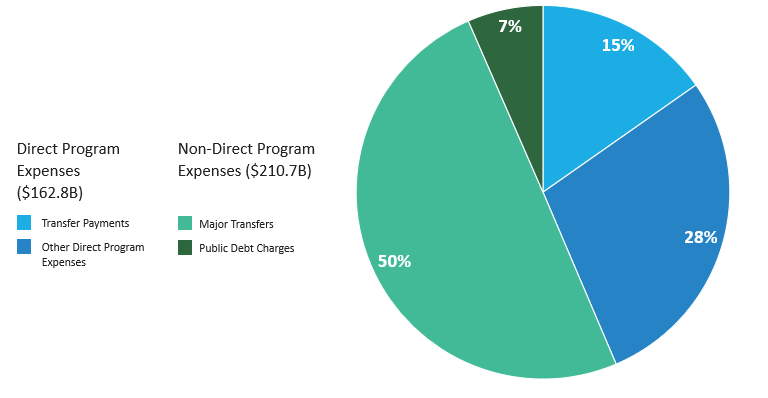
Text version
Pie chart depicting the four categories of Government of Canada Expenses. Transfer payments occupy 15%, other direct program expenses occupy 28%, major transfers occupy 50%, and public debt charges occupy 7%.
Government of Canada Expenses in 2019-20, by Type of Programming
Major transfers represent half of total government expenses, while other direct program expenses cover another third.
Note: Net actuarial losses included under ‘Other Direct Program Expenses’.
Source: Annual Financial Report of the Government of Canada, 2019-20
Net Budgetary Expenditures
Planned statutory expenditures (payments made under legislation previously approved by Parliament) as a proportion of government spending are decreasing, from 60.6% in 2019-20 to 56.7% in 2021-22. Overall government spending is increasing from $303.6B in 2019-20 to $383.4B planned for 2021-22 due to the COVID-19 response.
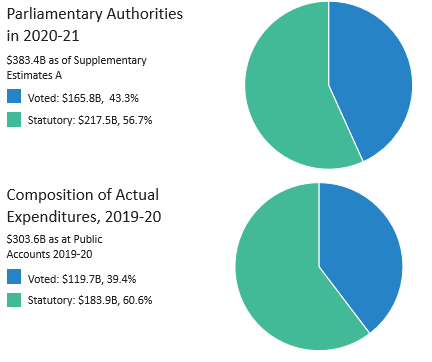
Text version
Parliamentary Authorities
Supplementary Estimates A. Voted expenditures totaled 165.8 billion dollars (43.3%), while statutory expenditures totaled 217.5 billion dollars (56.7%).
Composition of Actual Expenditures
Pie chart displaying the composition of actual expenditures in 2019-2020. which totaled 303.6 billion dollars as at Public Accounts, 2019-2020. Voted expenditures totaled 119.7 billion dollars (39.4%), while statutory expenditures totaled 183.9 billion dollars (60.6%).
| Voted | Statutory | |
|---|---|---|
| *Other Budgets include: Treasury Board central votes, payments to Crown corporations. Source: Treasury Board Secretariat, June 2021 |
||
| Transfer to Persons | $62.8B | |
| Transfer to Other Levels of Governments | $2.6B | $86.6B |
| Other Transfer Payments | $61.6B | |
| Operating and Other Budgets* | $91.3B | |
| Capital Payments | $10.3B | |
| Other Statutory Payments | $46.7B | |
| Public Debts | $21.3B | |
| Total | $165.8B (43.3%) |
$217.5B (56.7%) |
Voted Authorities and Expenditures
Government expenditures have generally risen over time, reaching $119.7 billion in 2019-20.
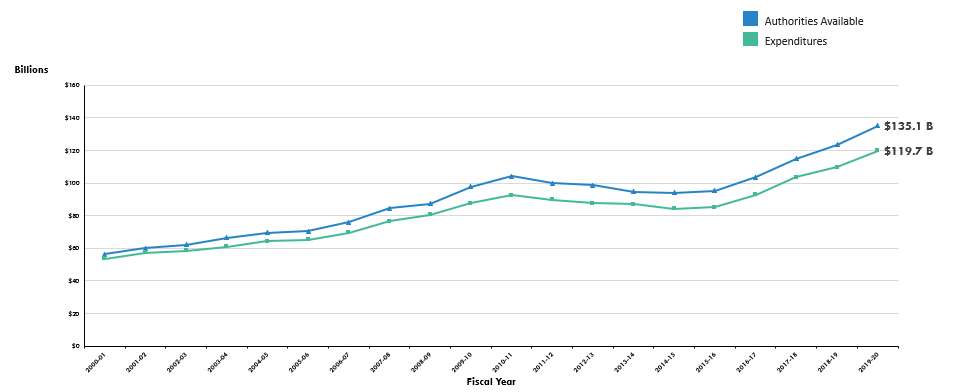
Text version
Comparative line graph describing voted authorities and expenditures. The X-axis shows the fiscal year, and the Y-axis shows dollars in billions.
| Year | Authorities Available | Expenditures |
|---|---|---|
| 2000-2001 | $56,281,843,494 | $53,537,319,238 |
| 2001-2002 | $60,112,380,622 | $58,511,725,864 |
| 2002-2003 | $62,100,877,459 | $58,511,725,864 |
| 2003-2004 | $66,469,403,726 | $61,037,036,358 |
| 2004-2005 | $69,592,889,313 | $64,217,385,492 |
| 2005-2006 | $70,379,179,525 | $65,210,027,059 |
| 2006-2007 | $75,825,284,975 | $69,633,087,434 |
| 2007-2008 | $84,635,295,932 | $76,603,718,101 |
| 2008-2009 | $87,343,158,866 | $80,677,910,663 |
| 2009-2010 | $97,629,693,338 | $87,471,108,579 |
| 2010-2011 | $104,281,201,649 | $92,636,171,227 |
| 2011-2012 | $99,894,737,416 | $89,717,871,422 |
| 2012-2013 | $98,646,872,817 | $87,708,965,710 |
| 2013-2014 | $94,753,671,352 | $86,881,410,076 |
| 2014-2015 | $93,954,663,634 | $84,160,464,446 |
| 2015-2016 | $95,358,197,661 | $85,169,699,945 |
| 2016-2017 | $103,671,334,330 | $92,748,873,806 |
| 2017-2018 | $115,035,108,699 | $103,688,179,872 |
| 2018-2019 | $123,594,789,126 | $109,783,245,643 |
| 2019-2020 | $135,125,309,893 | $119,731,891,080 |
* Budgetary authorities and expenditures exclude non-budgetary outlays related to loans, investments and advances.
** Voted authorities and expenditures are approved through supply bills with unused authorities lapsing at the end of the year. They exclude spending that is authorized on a continuing basis through statutes such as the Federal-Provincial Fiscal Arrangements Act or the Employment Insurance Act.
Source: Treasury Board Secretariat, December 2020
Expenses as a Percentage of Gross Domestic Product (GDP)
Expenses have remained relatively constant as a percentage of GDP.

Text version
Line graph describing expenses as a percentage of gross domestic product (GDP). The X-axis shows the fiscal year, and the Y-axis shows the percentage of GDP.
| Year | GDP |
|---|---|
| 2000-2001 | 15.8% |
| 2001-2002 | 15.4% |
| 2002-2003 | 15.4% |
| 2003-2004 | 15.3% |
| 2004-2005 | 15.9% |
| 2005-2006 | 14.9% |
| 2006-2007 | 15% |
| 2007-2008 | 15% |
| 2008-2009 | 14.9% |
| 2009-2010 | 17.6% |
| 2010-2011 | 16.5% |
| 2011-2012 | 15.5% |
| 2012-2013 | 15.1% |
| 2013-2014 | 14.6% |
| 2014-2015 | 14.1% |
| 2015-2016 | 14.8% |
| 2016-2017 | 15.3% |
| 2017-2018 | 15.4% |
| 2018-2019 | 15.6% |
| 2019-2020 | 16.2% |
*Expenses are recorded when incurred, as opposed to expenditures which are recorded when the cash is paid. Expenses encompass all spending by the Government of Canada, including direct program expenses, major transfers to people and other levels of government and public debt charges.
Source: Fiscal Reference Tables, 2020
Federal Government Compensation
Total Federal Government Compensation Costs (2019-20)
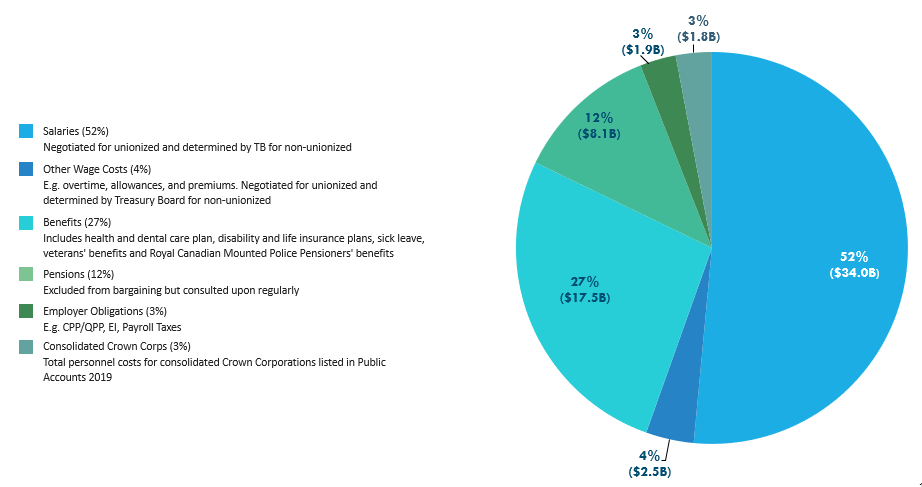
Text version
A pie chart breaks down Federal Government Compensation costs in 2019-20.
Salaries totaled $34 billion, and made up 52% of total federal compensation costs.
Other wage costs totaled $2.5 billion, and made up 4% of total federal compensation costs.
Benefits totaled $17.5 billion, and made up 27% of total federal compensation costs.
Pensions totaled $8.1 billion, and made up 12% of total federal compensation costs.
Employer obligations totaled $1.9 billion, and made up 3% of total federal compensation costs.
Consolidated Crown Corporation personnel costs totaled $1.8 billion, and made up 3% of total federal compensation cos
*Note: Compensation costs by component, e.g., salaries, pensions and benefits, are not available for Crown corporations. The sum of compensation components may not be equal to the total compensation cost due to rounding. Data as of June 2021.
Source: Treasury Board Secretariat, June 2021
Personnel Expenses*

Text version
Comparative line graph describing Government of Canada personnel expenses. The Y-axis shows the dollars in billions, and the X-axis shows the date.
In the 2010 to 2011 fiscal year, personnel expenses were $42,297,102,000 and professional and special services were an additional $7,902,900,000.
In the 2011 to 2012 fiscal year, personnel expenses were $43,837,673,000 and professional and special services were an additional $7,997,818,000.
In the 2012 to 2013 fiscal year, personnel expenses were $46,133,475,000 and professional and special services were an additional $7,513,860,000.
In the 2013 to 2014 fiscal year, personnel expenses were $44,993,653,000 and professional and special services were an additional $7,753,524,000.
In the 2014 to 2015 fiscal year, personnel expenses were $43,810,483,000 and professional and special services were an additional $8,090,232,000.
In the 2015 to 2016 fiscal year, personnel expenses were $50,170,703,000 and professional and special services were an additional $8,353,052,000.
In the 2016 to 2017 fiscal year, personnel expenses were $50,107,857,000 and professional and special services were an additional $9,701,836,000.
In the 2017 to 2018 fiscal year, personnel expenses were $60,293,462,000 and professional and special services were an additional $10,404,283,000.
In the 2018 to 2019 fiscal year, personnel expenses were $57,682,000,000 billions and professional and special services were an additional $11,036,000,000.
In the 2019 to 2020 fiscal year, personnel expenses were $65,793,806,000 and professional and special services were an additional $11,042,332,000.
From 2010-11 to 2019-20, personnel expenses averaged $48.8B. As of 2019-20, personnel expenses were $65.8B.
Personnel expenses include ‘net actuarial losses’ which, as of the 2019-20 Public Accounts, displays this amount separately. In 2019-20, personnel expenses increased to $65.8B from $57.7B in the previous year, largely attributed to higher amortization costs for benefits and pensions.
The approximate 16% average determinate workforce (term, casual, student) and other temporary service (professional and special services) provide some workforce flexibility.
*Data as of June 2021.
Source: Public Accounts of Canada
Correction
Please note that the title of the graph should refer to Government of Canada personnel “expenses” rather than “expenditures.”
People
Public Sector Profile
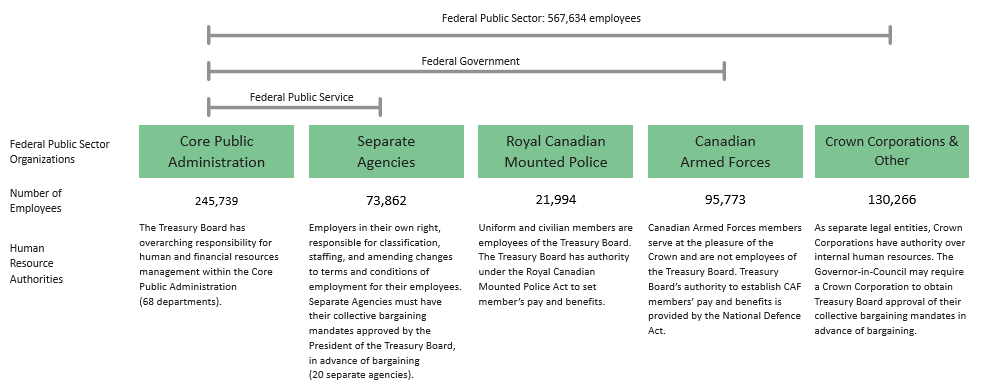
Text version
The composition of the federal public sector. Text version below.
| Federal public sector organizations | Core Public Administration | Separate Agencies | Royal Canadian Mounted Police | Canadian Armed Forces | Crown Corporations and Other |
|---|---|---|---|---|---|
| Number of employees | 245,739 | 73,862 | 21,994 | 95,773 | 130,266 |
| Human resource authorities | The Treasury Board has overarching responsibility for human and financial resources management within the Core Public Administration |
Employers in their own right, responsible for classification, staffing, and amending changes to terms and conditions of employment for their employees. Separate Agencies must have their collective bargaining mandates approved by the President of the Treasury Board, in advance of bargaining |
Uniform and civilian members are employees of the Treasury Board. The Treasury Board has authority under the RCMP Act to set member’s pay and benefits. |
CAF members serve at the pleasure of the Crown and are not employees of the Treasury Board. Treasury Board’s authority to establish CAF members’ pay and benefits is provided by the National Defence Act. |
As separate legal entities, Crown Corporations have authority over internal human resources. The Governor-in-Council may require a Crown Corporation to obtain Treasury Board approval of their collective bargaining mandates in advance of bargaining. |
The federal public sector has 567,634 employees and is made up of:
- the Core Public Administration (245,739 employees)
- Separate Agencies (73,862 employees)
- the Royal Canadian Mounted Police (21,994 employees)
- the Canadian Armed Forces (95,773 employees), and
- Crown Corporations and other organizations (130,266 employees).
The federal government is made up of:
- the Core Public Administration (245,739 employees)
- Separate Agencies (73,862 employees)
- the Royal Canadian Mounted Police (21,994 employees), and
- the Canadian Armed Forces (95,773 employees).
The federal public service is made up of:
- the Core Public Administration (245,739 employees), and
- Separate Agencies (73,862 employees).
Note: The Royal Canadian Mounted Police regular force (uniform) and civilian members as well as the Royal Canadian Mounted Police civilian staff hired under the Public Service Employment Act fall within the core public administration (CPA) according to the Financial Administration Act. However, the Royal Canadian Mounted Police regular force and civilian members are not included in the Treasury Board Secretariat’s Core Public Administration numbers as their data is not captured in the pay system and thus cannot be reported on by the various demographics. For this reason, Royal Canadian Mounted Police regular force and civilian members are reported on separately to ensure that the Core Public Administration total aligns across various publications, reports and slides.
Source: Treasury Board Secretariat, March 2021
Geographic Distribution of the Federal Public Service Workforce
43.4% of public servants work in the National Capital Region (NCR). An additional 24.9% work in Ontario and Quebec (excluding the National Capital Region).
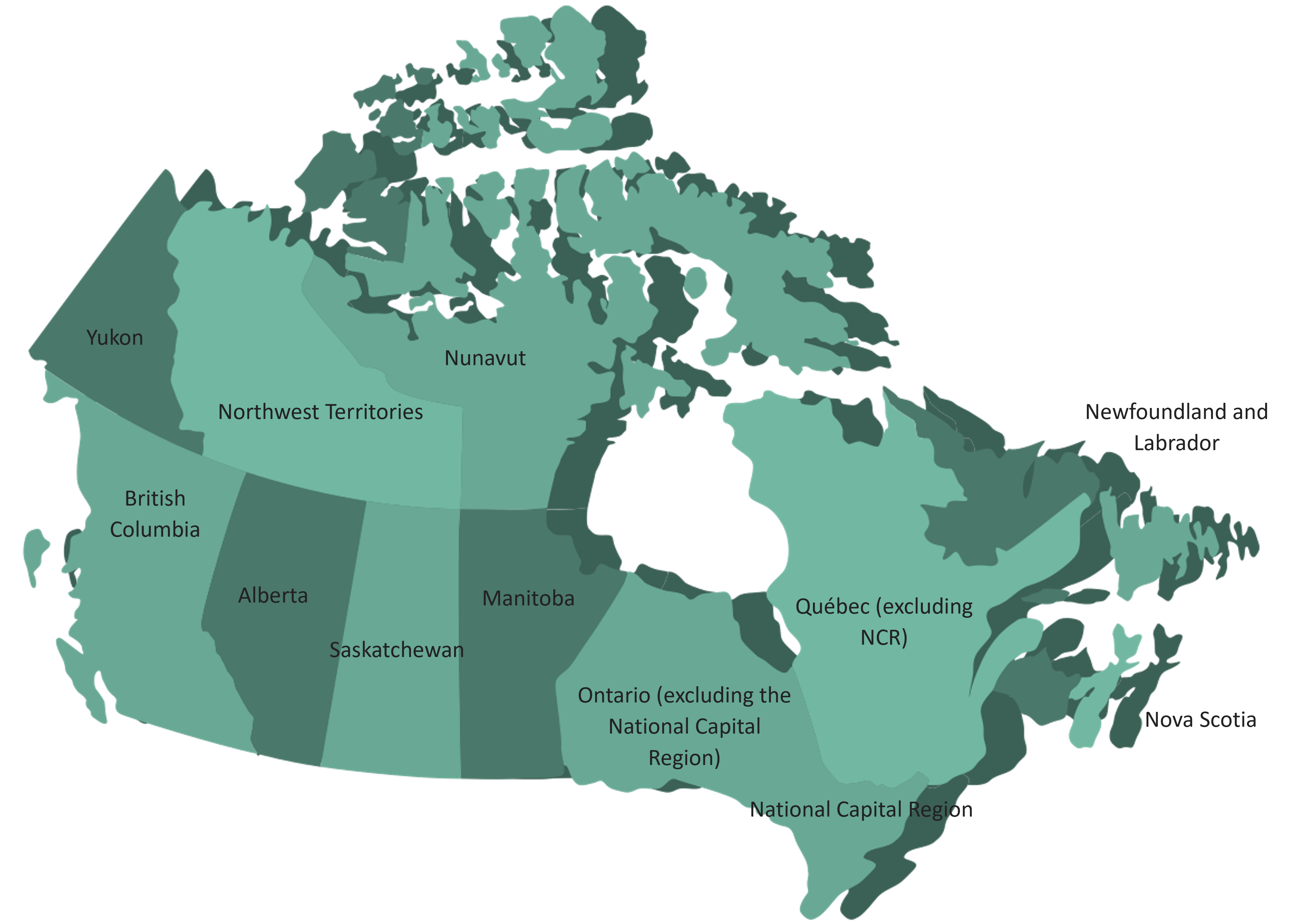
Yukon
427 Employees (0.1% of total)
Northwest Territories
571 Employees (0.2% of total)
Nunavut
334 Employees (0.1% of total)
British Columbia
26,464 Employees (8.5% of total)
Alberta
17,511 Employees (5.6% of total)
Saskatchewan
6,242 Employees (2.0% of total)
Manitoba
12,156 Employees (3.9% of total)
Ontario (excluding NCR)
43,503 Employees (14.0% of total)
National Capital Region
134,817 Employees (43.4% of total)
Québec (excluding NCR)
33,981 Employees (10.9% of total)
New Brunswick
10,881 Employees (3.5% of total)
Nova Scotia
11,806 Employees (3.8% of total)
Prince Edward Island
3,888 Employees (1.3% of total)
Newfoundland and Labrador
6,852 Employees (2.2% of total)
Outside Canada
1,323 Employees (0.4% of total)
The Federal Public Service includes the Core Public Administration and Separate Agencies.
Excludes those with missing location information (8,845 employees). Source: Treasury Board Secretariat, March 31,
2021
Workforce Overview
| Agents | Members |
|---|---|
| Source: Treasury Board Secretariat, data as of March 31, 2021 | |
| Public Service Alliance of Canada | 124k |
| Professional Institute of the Public Service of Canada | 42.8k |
| Canadian Association of Professional Employees | 20.4k |
| Union of Canadian Correctional Officers | 6.3k |
| Association of Canadian Financial Officers | 5.4k |
| Other Bargaining Agents (FCDTLC-W, FGDTLC-E, CUPE, CFPA, UNIFOR, CMCFA, FGDCA) |
2.6k |
| Association of Justice Counsel | 2.8K |
| Professional Association of Foreign Service Officers | 1.9k |
| International Brotherhood of Electrical Workers | 1.1k |
| Canadian Merchant Services Guild | 1.2k |
- 85% of the 245,739 employees in the Core Public Administration (CPA) are unionized
- 209K unionized members represented by 16 Bargaining Agents
- 60% of unionized members represented by the Public Service Alliance of Canada
- 20% of unionized members represented by the Professional Institute of the Public Service of Canada
- 20% of unionized members represented by the other Bargaining Agents
- 28 Collective Agreements
Core Public Administration (CPA) by Occupational Group
About 38% of employees in the CPA work in Administrative Services (AS), Program Administration (PM), or Clerical and Regulatory (CR). Outside the National Capital Region, this proportion increases to 42%.

Text version
Six bar graphs showing the share of key occupations in the Core Public Administration population, from March 2017 to Marcy 2021.
The y axis shows the percentage of the Core Public Administration workforce, and the x axis shows occupational group.
In 2017, the Administrative Services (AS) occupational group made up 14.4% of the Core Public Administration workforce. In 2018, it made up 14.7%. In 2019, it made up 15.4%. In 2020, it made up 16%. In 2021, it made up 16%.
In 2017, the Programme Administration (PM) occupational group made up 11.8% of the Core Public Administration workforce. In 2018, it made up 11.8%. In 2019, it made up 11.6%. In 2020, it made up 12.3%. In 2021, it made up 13.8%.
In 2017, the Clerical and Regulatory (CR) occupational group made up 10.8% of the Core Public Administration workforce. In 2018, it made up 10.6%. In 2019, it made up 10.2%. In 2020, it made up 9.2%. In 2021, it made up 8.5%.
In 2017, the Economics and Social Sciences Services (EC) occupational group made up 7.1% of the Core Public Administration workforce. In 2018, it made up 7.4%. In 2019, it made up 7.8%. In 2020, it made up 8.2%. In 2021, it made up 8.6%.
In 2017, the Computer Systems (CS) occupational group made up 6.8% of the Core Public Administration workforce. In 2018, it made up 6.8%. In 2019, it made up 7%. In 2020, it made up 7.2%. In 2021, it made up 7.2%.
In 2017, the Executive (EX) occupational group made up 2.6% of the Core Public Administration workforce. In 2018, it made up 2.5%. In 2019, it made up 2.6%. In 2020, it made up 2.6%. In 2021, it made up 2.6%.
| Executive Occupational Group | 2017 | 2018 | 2019 | 2020 | 2021 |
|---|---|---|---|---|---|
| Notes:
|
|||||
| Administrative Services (AS) | 28,663 | 30,716 | 33,940 | 36,943 | 39,339 |
| Programme Administration (PM) | 23,486 | 24,591 | 25,592 | 28,428 | 33,939 |
| Clerical and Regulatory (CR) | 21,597 | 22,041 | 22,441 | 21,227 | 20,876 |
| Economics and Social Science Services (EC) | 14,163 | 15,496 | 17,290 | 18,876 | 21,081 |
| Computer Services (CS) | 13,601 | 14,209 | 15,489 | 16,686 | 17,812 |
| Executive (EX) | 5,094 | 5,296 | 5,626 | 5,922 | 6,421 |
| Other | 93,087 | 95,963 | 99,937 | 103,094 | 106,271 |
| Core Public Administration Total | 199,691 | 208,312 | 220,315 | 231,176 | 245,739 |
Source: Treasury Board Secretariat, March 2021 (Pay System)
Correction
Please note that the reference to “Executive Occupational Group” is an error; it should read “Occupational Group.”
Official Language Status of Core Public Administration Positions
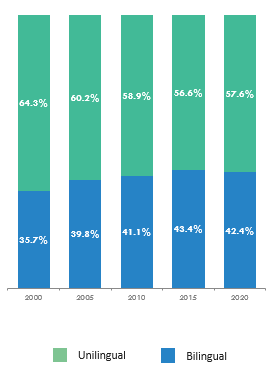
Text version
Bar graph describing the percentage of bilingual and unilingual positions. The x-axis shows the date and the Y-axis shows the percentage.
In 2000, 35.7% bilingual and 64.3% unilingual; in 2005, 39.8% bilingual and 60.2% unilingual; in 2010, 41.1% bilingual and 58.9% unilingual; in 2015, 43.4% bilingual and 56.6% unilingual; in 2020, 42.4% bilingual and 57.6% unilingual.
Source: TBS, March 2020
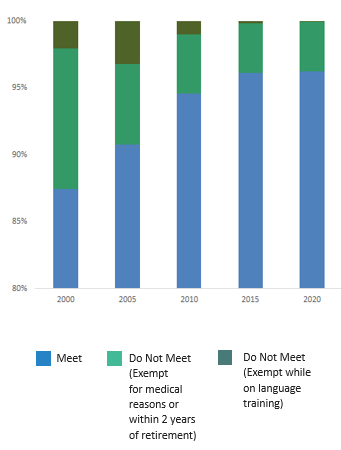
Text version
Bar graph describing the linguistic status of incumbents. The x-axis shows the percentage and the y-axis shows the year.
Source: TBS, March 2020
- The percentage of bilingual positions has increased from 35.7% in 2000 to 42.4% in 2020.
- In 2020, the National Capital Region (64.2%), Quebec (excluding the National Capital Region) (67.5%) and New Brunswick (50.7%) had the highest proportion of bilingual positions.
- Between 2000 and 2015, the percentage of employees meeting the language requirements of their positions steadily increased. It has remained stable over the past six years.
Note: Includes Core Public Administration (CPA) employees only, indeterminate and terms 3 months or more.
- Official Languages data in the charts are up to March 2020.
- Official Languages data for the FY 2020-21 will be published in the Official Languages Annual Report in 2021.
Employment Equity (EE) in the Core Public Administration
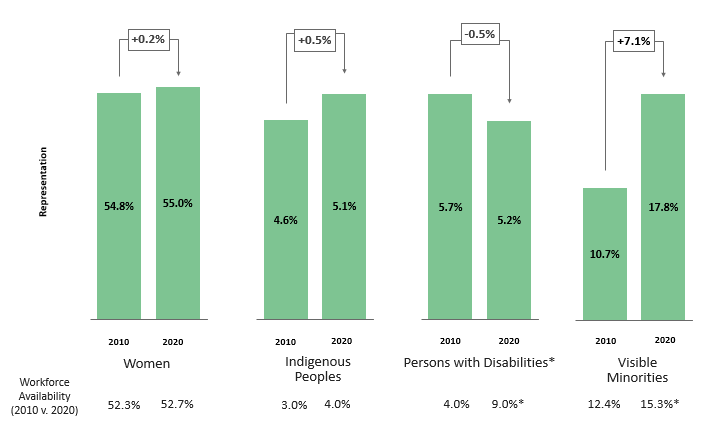
Text version
Four bar graphs describing employment equity in the CPA by designated group. The X-axis shows the date and the Y-axis shows designated group representation in the public service by percentage. Below the bar graphs is a chart showing the work force availability of employment equity groups in 2010 and 2020.
The first bar graph shows women. In 2010, women represented 54.8% of those in the public service and in 2020, this number increased by 0.2% to 55%. In 2010, the workforce availability for women was 52.3%; in 2020, it was 52.7%.
The second bar graph shows Indigenous Peoples. In 2010, Indigenous Peoples represented 4.6% of those in the public service and in 2020, this number increased by 0.5% to 5.1%. In 2010, the workforce availability for Indigenous peoples was 3%; in 2020, it was 4%.
The third bar graph shows persons with disabilities. In 2010, persons with disabilities represented 5.7% of those in the public service and in 2020, this number decreased by 0.5% to 5.2%.
The 2017 Canadian Survey on Disabilities expanded the definition of Persons with Disabilities (PwD) to include disabilities relating to pain and mental health. Work Force Availability in 2020 for PwD when adjusted to the former definition of PwD is close to 2010 representation.
In 2010, the workforce availability for persons with disabilities was 4%; in 2020, it was 9%.
The fourth bar graph shows visible minorities. In 2010, visible minorities represented 10.7% of those in the public service, and in 2020, this number increased by 7.1% to 17.8%. In 2010, the workforce availability for visible minorities was 12.4%; in 2020, it was 15.3%.
*The 2017 Canadian Survey on Disabilities expanded the definition of Persons with Disabilities (PwD) to include disabilities relating to pain and mental health. Work Force Availability in 2020 for Persons with Disabilities when adjusted to the former definition of Persons with Disabilities is close to 2010 representation.
Source: Treasury Board Secretariat, Treasury Board Secretariat-Office of the Chief Human Resources Officer as of March 31, 2010, and March 31, 2020
Overall, employment equity (EE) representation of women, Indigenous peoples and members of visible minorities across the public service has been improving, but there is much more work to be done.
Significant representation gaps persist at executive levels
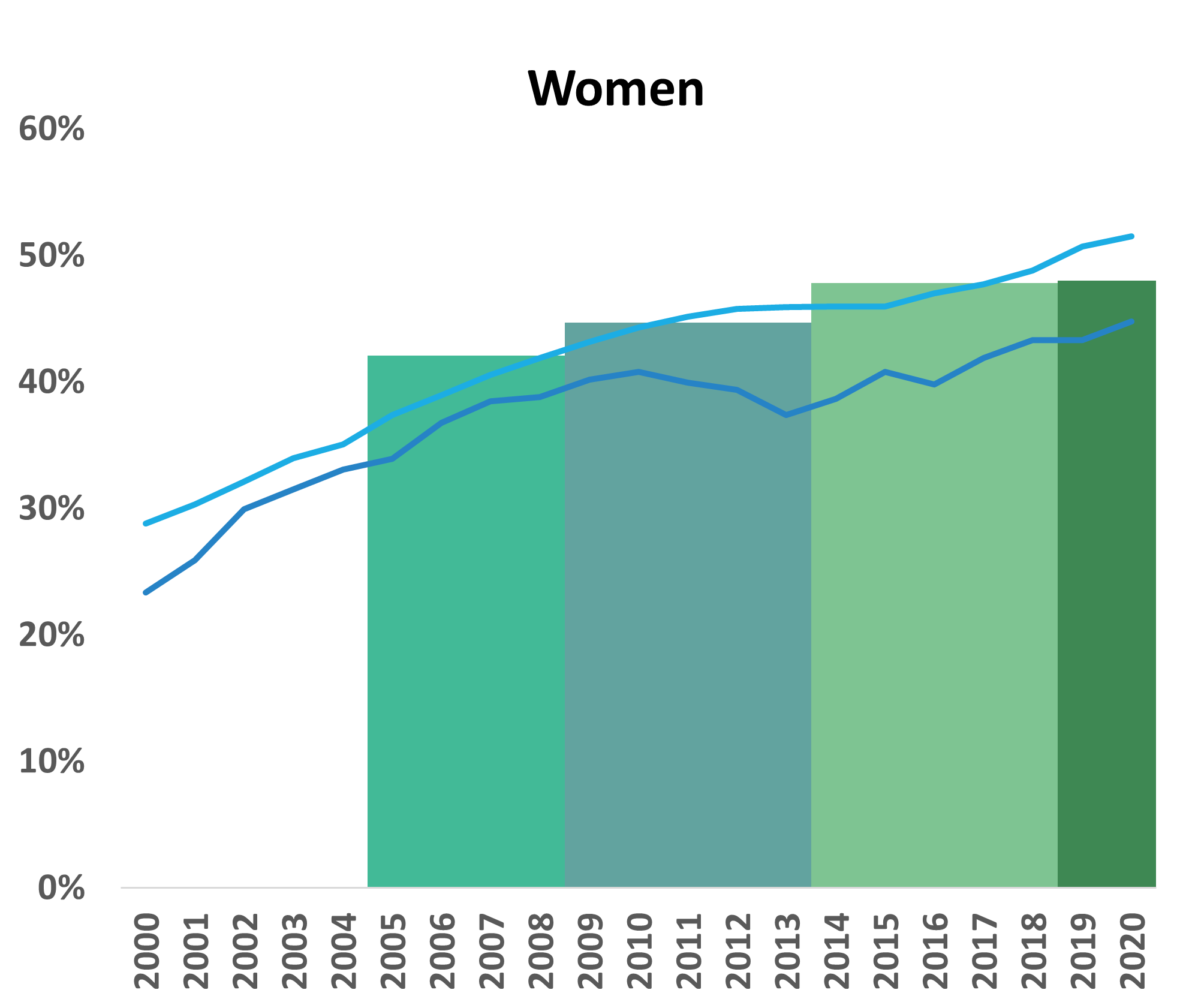
Text version
A combination line and bar graph; the line graph describes the representation of women by percentage at the executive level, and the bar graph shows executive workforce availability of women by percentage. The X-axis shows the year, and Y-axis shows the percentage.
| 2000 | 2005 | 2010 | 2015 | 2020 | |
|---|---|---|---|---|---|
| EX Work Force Availability | 42.1% | 44.7% | 47.8% | 48.0% | |
| EX-01 to EX-03 | 28.8% | 37.4% | 44.3% | 46.0% | 51.5% |
| Assistant Deputy Minister | 23.4% | 33.9% | 40.8% | 40.8% | 44.8% |
| 2000 | 2005 | 2010 | 2015 | 2020 | |
|---|---|---|---|---|---|
| EX Work Force Availability | 42.1% | 44.7% | 47.8% | 48.0% | |
| EX-01 to EX-03 | 28.8% | 37.4% | 44.3% | 46.0% | 51.5% |
| Assistant Deputy Minister | 23.4% | 33.9% | 40.8% | 40.8% | 44.8% |
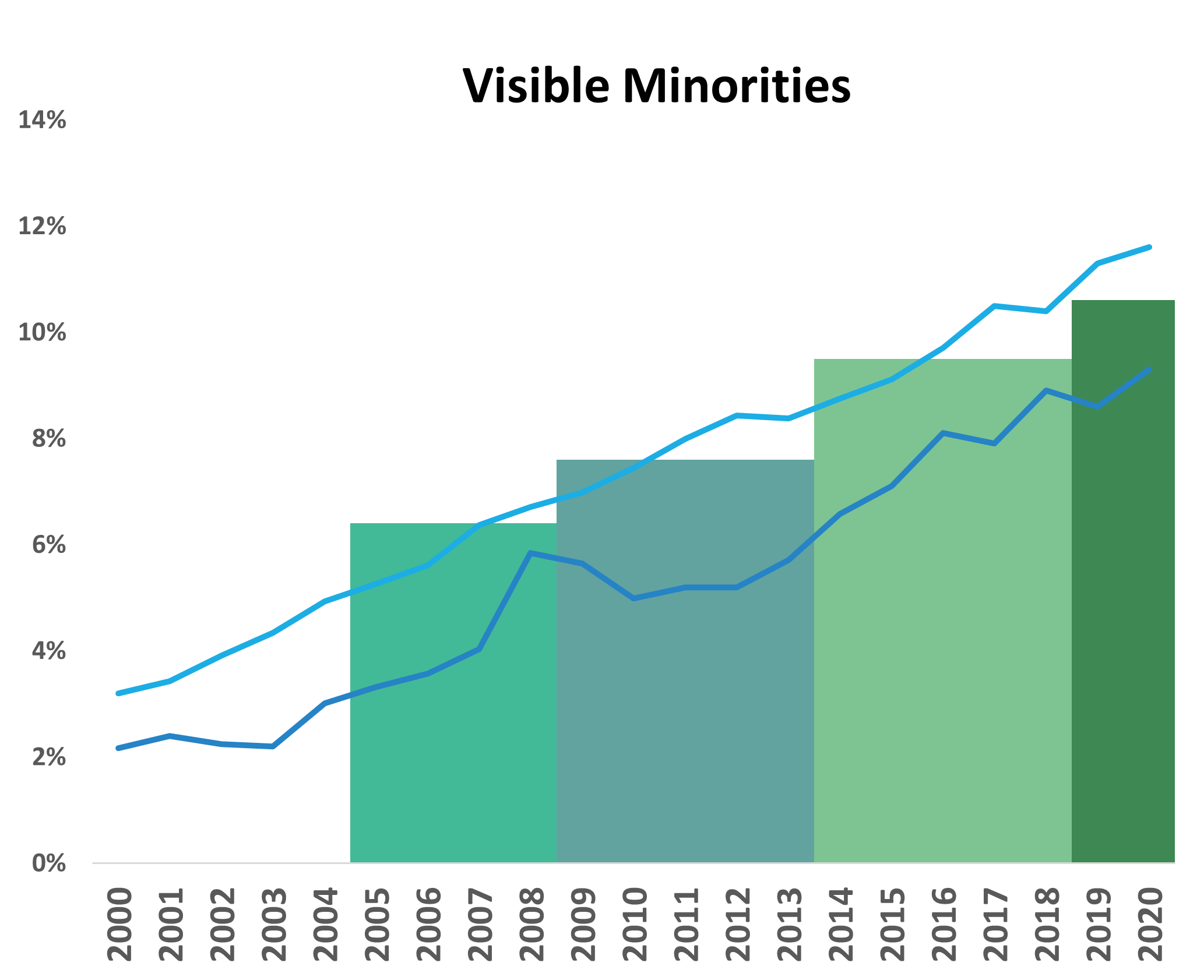
Text version
A combination line and bar graph; the line graph describes the representation of visible minorities by percentage at the executive level, and the bar graph shows executive workforce availability of visible minorities by percentage. The X-axis shows the year, and Y-axis shows the percentage.
| 2000 | 2005 | 2010 | 2015 | 2020 | |
|---|---|---|---|---|---|
| EX Work Force Availability | 6.4% | 7.6% | 9.5% | 10.6% | |
| EX-01 to EX-03 | 3.2% | 5.3% | 7.4% | 9.1% | 11.6% |
| Assistant Deputy Minister | 2.2% | 3.3% | 5.0% | 7.1% | 9.3% |
| 2000 | 2005 | 2010 | 2015 | 2020 | |
|---|---|---|---|---|---|
| EX Work Force Availability | 6.4% | 7.6% | 9.5% | 10.6% | |
| EX-01 to EX-03 | 3.2% | 5.3% | 7.4% | 9.1% | 11.6% |
| Assistant Deputy Minister | 2.2% | 3.3% | 5.0% | 7.1% | 9.3% |

Source: Pay System and Employment Equity Data Bank (EEDB) as of March 31st of each
year. The Law Management (LC) occupational group is included in representation and Work Force Availability (WFA) as of
March 31, 2020.
The 2020 Work Force Availability for persons with disabilities is based on the expanded definition of disability used
in the 2017 Canadian Survey on Disability, which includes episodic and non-visible disabilities. The 2020
representation of persons with disabilities is based on a previous definition.
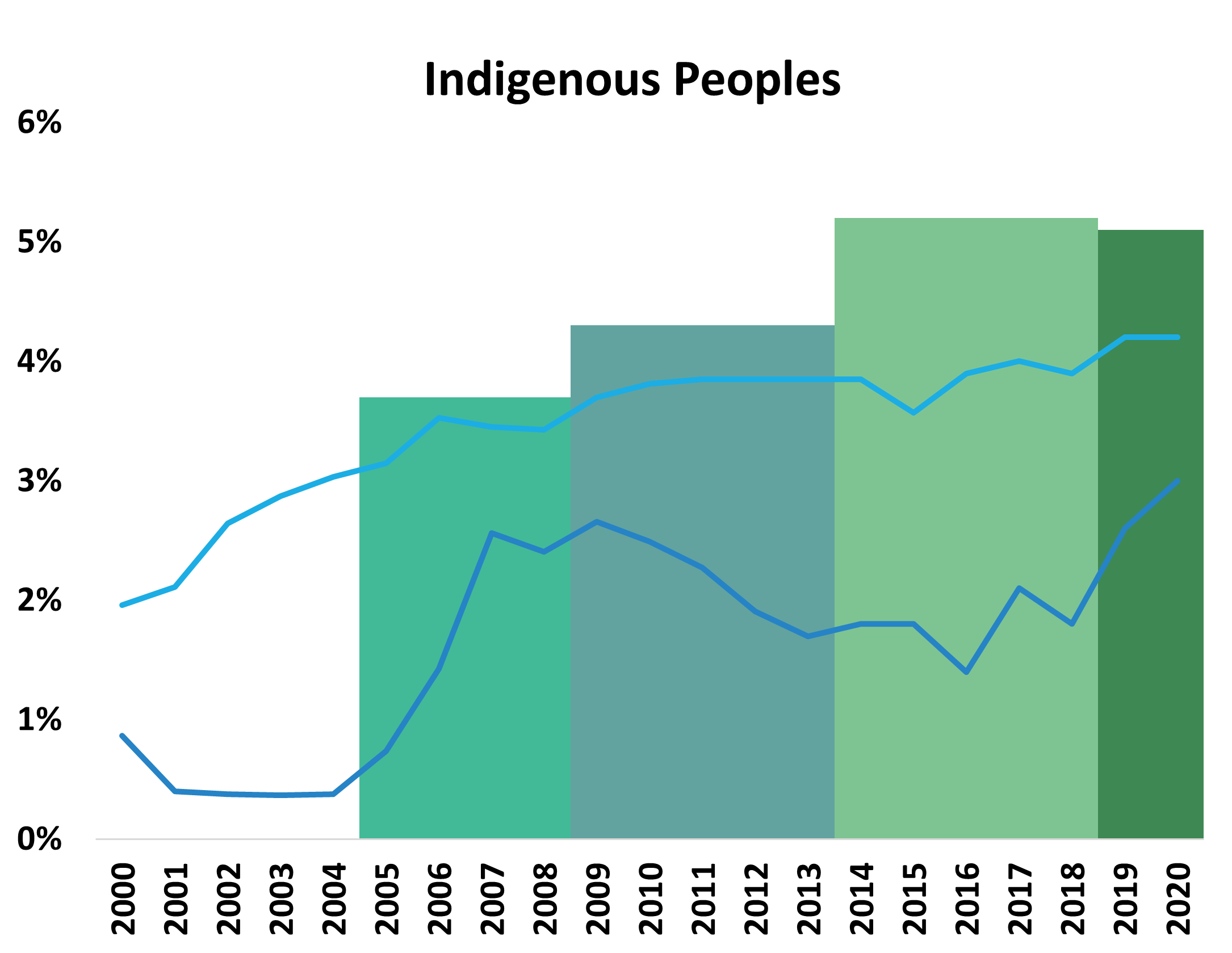
Text version
A combination line and bar graph; the line graph describes the representation of Indigenous peoples by percentage at the executive level, and the bar graph shows executive workforce availability of Indigenous peoples by percentage. The X-axis shows the year, and Y-axis shows the percentage.
| 2000 | 2005 | 2010 | 2015 | 2020 | |
|---|---|---|---|---|---|
| EX Work Force Availability | 3.7% | 4.3% | 5.2% | 5.1% | |
| EX-01 to EX-03 | 2.0% | 3.1% | 3.8% | 3.6% | 4.2% |
| Assistant Deputy Minister | 0.9% | 0.7% | 2.5% | 1.8% | 3.0% |
| 2000 | 2005 | 2010 | 2015 | 2020 | |
|---|---|---|---|---|---|
| EX Work Force Availability | 3.7% | 4.3% | 5.2% | 5.1% | |
| EX-01 to EX-03 | 2.0% | 3.1% | 3.8% | 3.6% | 4.2% |
| Assistant Deputy Minister | 0.9% | 0.7% | 2.5% | 1.8% | 3.0% |
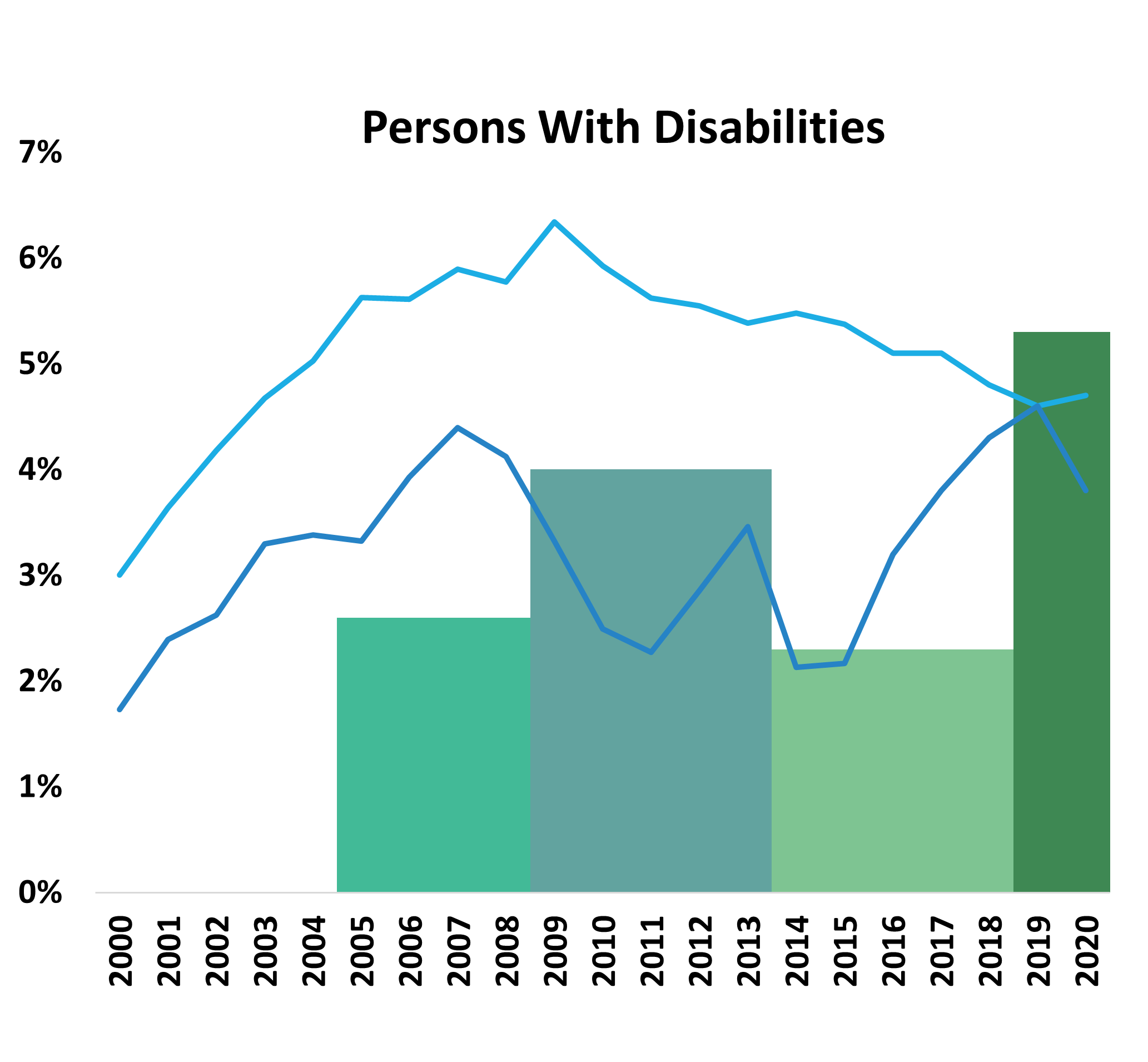
Text version
A combination line and bar graph; the line graph describes the representation of persons with disabilities by percentage at the executive level, and the bar graph shows executive workforce availability of persons with disabilities by percentage. The X-axis shows the year, and Y-axis shows the percentage.
| 2000 | 2005 | 2010 | 2015 | 2020 | |
|---|---|---|---|---|---|
| EX Work Force Availability | 2.6% | 4.0% | 2.3% | 5.3% | |
| EX-01 to EX-03 | 3.0% | 5.6% | 5.9% | 5.4% | 4.7% |
| Assistant Deputy Minister | 1.7% | 3.3% | 2.5% | 2.2% | 3.8% |
| 2000 | 2005 | 2010 | 2015 | 2020 | |
|---|---|---|---|---|---|
| EX Work Force Availability | 2.6% | 4.0% | 2.3% | 5.3% | |
| EX-01 to EX-03 | 3.0% | 5.6% | 5.9% | 5.4% | 4.7% |
| Assistant Deputy Minister | 1.7% | 3.3% | 2.5% | 2.2% | 3.8% |

Source: Pay System and Employment Equity Data Bank (EEDB) as of March 31st of each year. LCs are
included in representation and Work Force Availability (WFA) as of March 31, 2020.
The 2020 Work Force Availability for persons with disabilities is based on the expanded definition of disability used
in the 2017 Canadian Survey on Disability, which includes episodic and non-visible disabilities. The 2020
representation of persons with disabilities is based on a previous definition.
Digital
State of Information Technology (IT)
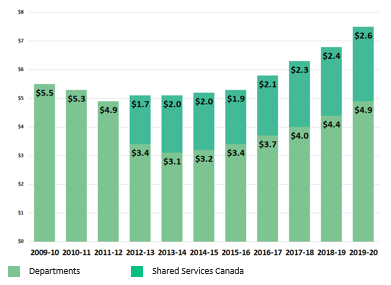
Text version
Comparative bar graph describing Government of Canada Information Technology (I.T.) Expenditures. The X-axis shows the year, and the Y-axis shows dollars in billions.
| Year | Departments | Shared Services Canada |
|---|---|---|
| 2009 to 2010 | 5.5 billion dollars on I.T. | |
| 2010 to 2011 | 5.3 billion dollars on I.T. | |
| 2011 to 2012 | 4.9 billion dollars on I.T. | |
| 2012 to 2013 | 3.4 billion dollars on I.T | 1.7 billion dollars on I.T. |
| 2013 to 2014 | 3.1 billion dollars on I.T | 2.0 billion dollars on I.T. |
| 2014 to 2015 | 3.2 billion dollars on I.T | 2.0 billion dollars on I.T. |
| 2015 to 2016 | 3.4 billion dollars on I.T | 1.9 billion dollars on I.T. |
| 2016 to 2017 | 3.7 billion dollars on I.T | 2.1 billion dollars on I.T. |
| 2017 to 2018 | 4.0 billion dollars on I.T | 2.3 billion dollars on I.T. |
| 2018 to 2019 | 4.4 billion dollars on I.T | 2.4 billion dollars on I.T. |
| 2019 to 2020 | 4.9 billion dollars on I.T | 2.6 billion dollars on I.T. |
Source: Departmental Information Technology Expenditure Reports
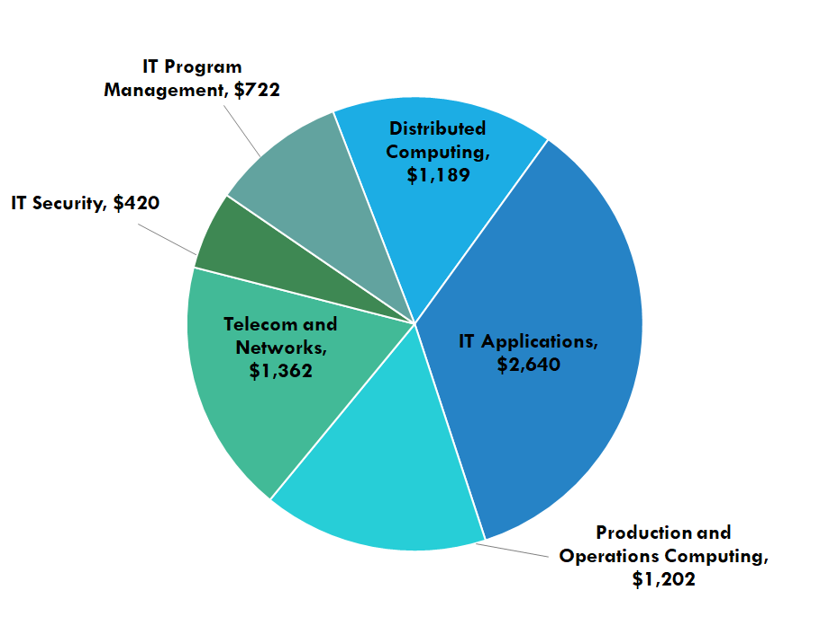
Text version
Pie chart describing Government of Canada Information Technology (I.T.) Expenditures by Category.
$722 million was spent on I.T. Program Management.
$420 million was spent on I.T. Security.
$1362 million was spent on Telecom and Networks.
$1202 million was spent on Production and Operations Computing.
$2640 million was spent on I.T. Applications.
$1189 million was spent on Distributed Computing.
Source: Departmental Information Technology Expenditure Reports for 2019-20
Correction
Please note that the graph entitled “Government of Canada Information Technology Expenditures by Category” displays figures in the millions of dollars.
Access to Information and Personal Information Requests
While the number of Personal Information Requests has fluctuated since 1983, the number of Access to Information Requests has steadily increased due mainly to a significant increase in requests submitted to Immigration, Refugees and Citizenship Canada since 2012-13. The number of requests to other institutions has been largely stable or in decline. Operational costs related to these requests are also rising.
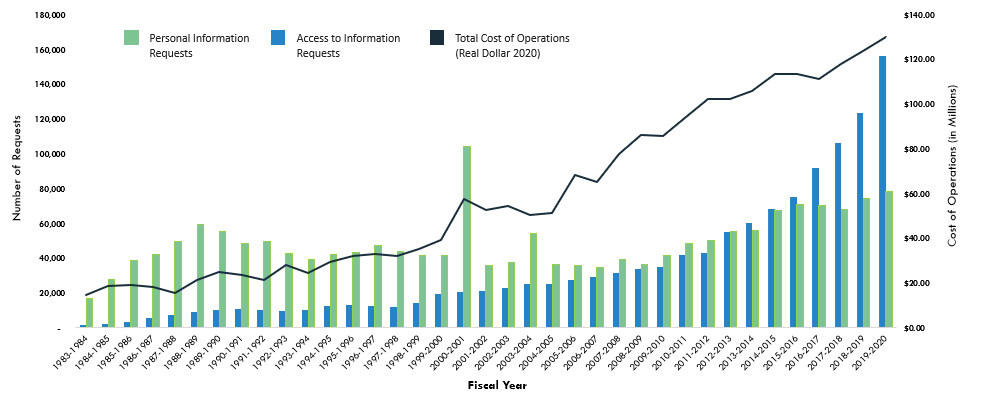
Text version
Comparative bar graph and line graph describing Access to Information and Personal Information requests. The left side of the Y-axis shows the number of requests, and the right side shows the cost of operations in millions. The X-axis shows the fiscal year.
In the 1983 to 1984 fiscal year, there were 1,513 access to information requests, and 17,109 personal information requests. The total cost of operations (real dollar 2020) was 14.81 million dollars.
In the 1984 to 1985 fiscal year, there were 2,229 access to information requests, and 27,547 personal information requests. The total cost of operations (real dollar 2020) was 18.95 million dollars.
In the 1985 to 1986 fiscal year, there were 3,606 access to information requests, and 38,606 personal information requests. The total cost of operations (real dollar 2020) was 19.35 million dollars.
In the 1986 to 1987 fiscal year, there were 5,450 access to information requests, and 42,292 personal information requests. The total cost of operations (real dollar 2020) was 18.15 million dollars.
In the 1987 to 1988 fiscal year, there were 7,301 access to information requests, and 49,626 personal information requests.
The total cost of operations (real dollar 2020) was 15.78 million dollars.
In the 1988 to 1989 fiscal year, there were 8,853 access to information requests, and 59,631 personal information requests. The total cost of operations (real dollar 2020) was 21.59 million dollars.
In the 1989 to 1990 fiscal year, there were 10,234 access to information requests, and 55,505 personal information requests. The total cost of operations (real dollar 2020) was 25.01 million dollars.
In the 1990 to 1991 fiscal year, there were 11,093 access to information requests, and 48,430 personal information requests. The total cost of operations (real dollar 2020) was 23.67 million dollars.
In the 1991 to 1992 fiscal year, there were 10,387 access to information requests, and 49,732 personal information requests. The total cost of operations (real dollar 2020) was 21.33 million dollars.
In the 1992 to 1993 fiscal year, there were 9,729 access to information requests, and 42,713 personal information requests. The total cost of operations (real dollar 2020) was 27.93 million dollars.
In the 1993 to 1994 fiscal year, there were 10,422 access to information requests, and 39,060 personal information requests. The total cost of operations (real dollar 2020) was 24.47 million dollars.
In the 1994 to 1995 fiscal year, there were 12,861 access to information requests, and 42,147 personal information requests. The total cost of operations (real dollar 2020) was 29.60 million dollars.
In the 1995 to 1996 fiscal year, there were 13,124 access to information requests, and 43,137 personal information requests. The total cost of operations (real dollar 2020) was 32.02 million dollars.
In the 1996 to 1997 fiscal year, there were 12,476 access to information requests, and 47,532 personal information requests.
The total cost of operations (real dollar 2020) was 33.16 million dollars.
In the 1997 to 1998 fiscal year, there were 12,206 access to information requests, and 43,648 personal information requests. The total cost of operations (real dollar 2020) was 32.25 million dollars.
In the 1998 to 1999 fiscal year, there were 14,340 access to information requests, and 41,498 personal information requests. The total cost of operations (real dollar 2020) was 35.20 million dollars.
In the 1999 to 2000 fiscal year, there were 19,294 access to information requests, and 41,585 personal information requests. The total cost of operations (real dollar 2020) was 39.37 million dollars.
In the 2000 to 2001 fiscal year, there were 20,789 access to information requests, and 104,133 personal information requests. The total cost of operations (real dollar 2020) was 57.79 million dollars.
In the 2001 to 2002 fiscal year, there were 21,265 access to information requests, and 36,137 personal information requests. The total cost of operations (real dollar 2020) was 52.77 million dollars.
In the 2002 to 2003 fiscal year, there were 22,977 access to information requests, and 37,863 personal information requests. The total cost of operations (real dollar 2020) was 54.62 million dollars.
In the 2003 to 2004 fiscal year, there were 25,234 access to information requests, and 54,377 personal information requests. The total cost of operations (real dollar 2020) was 50.55 million dollars.
In the 2004 to 2005 fiscal year, there were 25,207 access to information requests, and 36,316 personal information requests. The total cost of operations (real dollar 2020) was 51.58 million dollars.
In the 2005 to 2006 fiscal year, there were 27,269 access to information requests, and 36,090 personal information requests. The total cost of operations (real dollar 2020) was 68.38 million dollars.
In the 2006 to 2007 fiscal year, there were 29,182 access to information requests, and 34,559 personal information requests. The total cost of operations (real dollar 2020) was 65.25 million dollars.
In the 2007 to 2008 fiscal year, there were 31,487 access to information requests, and 39,134 personal information requests. The total cost of operations (real dollar 2020) was 77.79 million dollars.
In the 2008 to 2009 fiscal year, there were 34,041 access to information requests, and 36,454 personal information requests. The total cost of operations (real dollar 2020) was 86.36 million dollars.
In the 2009 to 2010 fiscal year, there were 35,154 access to information requests, and 41,621 personal information requests. The total cost of operations (real dollar 2020) was 85.79 million dollars.
In the 2010 to 2011 fiscal year, there were 41,641 access to information requests, and 48,755 personal information requests. The total cost of operations (real dollar 2020) was 94.22 million dollars.
In the 2011 to 2012 fiscal year, there were 43,194 access to information requests, and 50,524 personal information requests. The total cost of operations (real dollar 2020) was 102.32 million dollars.
In the 2012 to 2013 fiscal year, there were 55,145 access to information requests, and 55,355 personal information requests. The total cost of operations (real dollar 2020) was 102.53 million dollars.
In the 2013 to 2014 fiscal year, there were 60,105 access to information requests, and 56,263 personal information requests.
The total cost of operations (real dollar 2020) was 105.96 million dollars.
In the 2014 to 2015 fiscal year, there were 68,193 access to information requests, and 67,399 personal information requests. The total cost of operations (real dollar 2020) was 113.30 million dollars.
In the 2015 to 2016 fiscal year, there were 75,387 access to information requests, and 70,833 personal information requests. The total cost of operations (real dollar 2020) was 113.66 million dollars.
In the 2016 to 2017 fiscal year, there were 91,880 access to information requests, and 70,490 personal information requests. The total cost of operations (real dollar 2020) was 111.43 million dollars.
In the 2017 to 2018 fiscal year, there were 106,255 access to information requests, and 67,967 personal information requests. The total cost of operations (real dollar 2020) was 117.99 million dollars.
In the 2018 to 2019 fiscal year, there were 123,421 access to information requests, and 74,566 personal information requests. The total cost of operations (real dollar 2020) was 123.90 million dollars.
In the 2019 to 2020 fiscal year, there were 156,255 access to information requests, and 78,565 personal information requests. The total cost of operations (real dollar 2020) was 130.03 million dollars.
The Access to Information Act and Privacy Act provide a right to request government information and one’s own
personal information held by the Government of Canada. The spike in personal information requests in 2000-01 followed
the Privacy Commissioner’s 1999-2000 Annual Report which highlighted a database that contained significant personal
information about Canadians.
Source: Treasury Board Secretariat
Digital Access and Service Channel Preferences
Canadians access services via in-person, online and by phone at a relatively equal rate.
Service channel use for Government of Canada services according to the Citizens First Report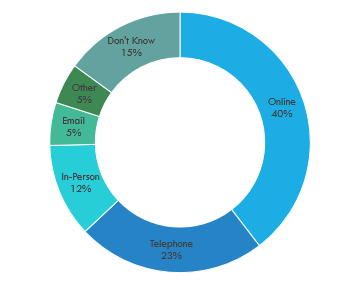
Text version
Pie chart describing digital access and service channel preferences. It outlines service channel use for Government of Canada services according to the Citizens First Report. Online occupies 40%, telephone occupies 23%, in-person occupies 12%, email occupies 5%, other occupies 5%, and don't know occupies 15%.
Source: CitizensFirst 9 National Report (Institute for Citizen-Centred Service)
Overall, internal and external clients completed 425 million* transactions with the Government of Canada across various channels. Three of these channels were accessed as follows:
- 40%
online - 21%
by telephone - 26%
in-person
20% of Government of Canada Services offer services online, by telephone and in-person. Usage rates are different when clients can choose from these three available channels
- 12%
online - 75%
by telephone - 4%
in-person
Source: Government of Canada Service Inventory (2019-2020) - open.Canada.ca
*Includes border crossings
Government of Canada External Services
Overall Scope
- 74 Departments*
- 474 Programs
- 1,117 Services
- 360 Priority services
Transactions Processed
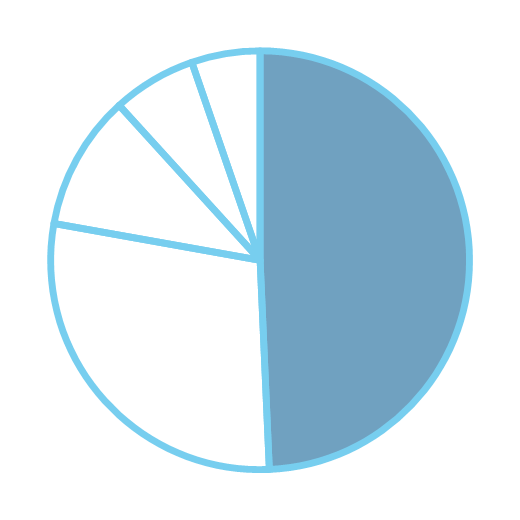
157M Online Applications
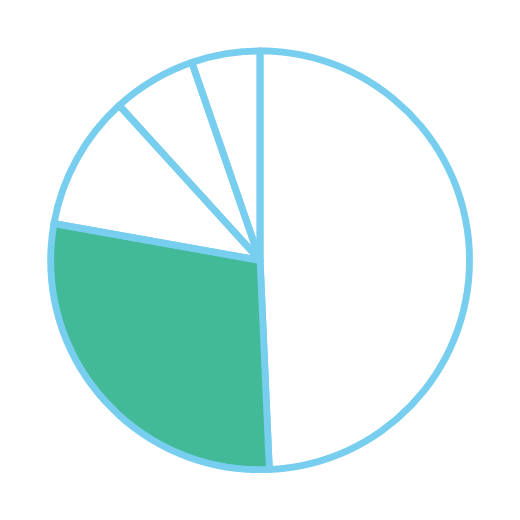
91M Telephone Calls and Applications
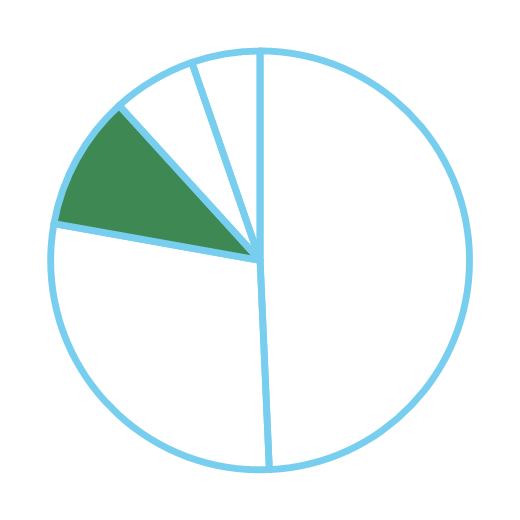
33M Mail Applications

17M In-person Applications**
Service Performance
Out of a total of 207 priority services from Large Departments and Agencies

42% of GC services can be completed on-line from end-to-end

Overall, 54% of all steps required to receive a service were available online
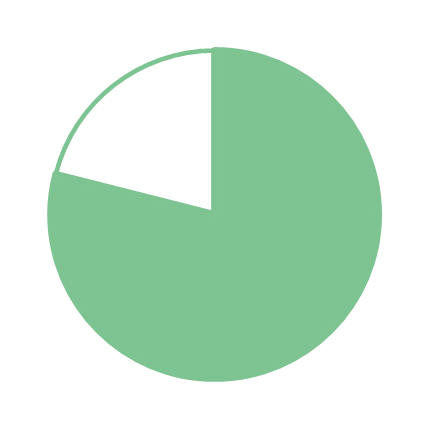
79% of GC services met their service standard targets in 2019-20
*Out of 84 organizations subject to the Policy on Service and Digital
** In-person applications does not include border crossings of 94 million (also known as traveller processing).
Note: Remaining transactions processed are via other channels such as email, fax or radio.
Clients include: persons (citizens and non-citizens), foreign entities, businesses, non-profits, provinces, territories and communities
Source: Government of Canada Service Inventory (2019-2020) - open.Canada.ca
Assets and Procurement
What We Own: Government of Canada Assets
Treasury Board sets the policy direction for the management of assets and acquired services and makes decisions on departmental proposals, such as investment plans and individual projects
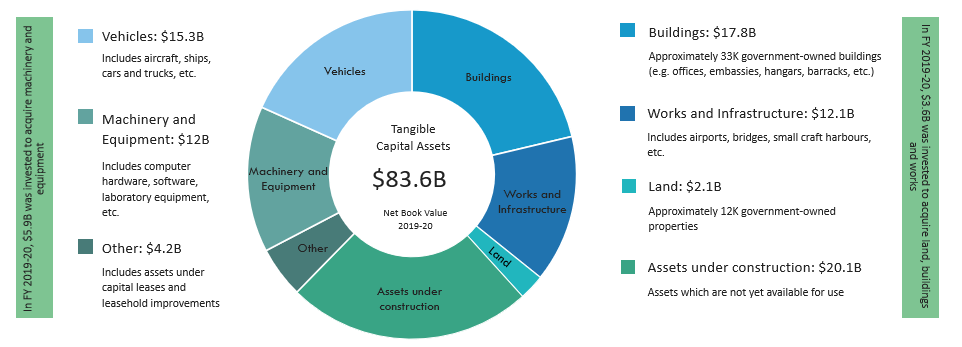
Text version
Pie chart describing Government of Canada tangible capital assets, for a total of 83.6 billion dollars in net book value in the 2019 to 2020 fiscal year.
Vehicles occupy 15.3 billion dollars. Machinery and equipment occupy 12 billion dollars. Buildings occupy 17.8 billion dollars. Works infrastructure occupies 12.1 billion dollars. Land occupies 2.1 billion dollars. Assets under construction occupies 20.1 billion dollars. Finally, other assets occupy 4.2 billion dollars.
Source: 2019-20 Public Accounts Volume 1, Tangible Capital Assets and Volume III, section 5; the Directory of Federal Real Property (government-owned land and buildings)
Procurement
A very steady pattern of concentration of high-volume, low-value contracts and low-volume, high-value contracts has been seen over the past decade.
- $21.3B
Total cost of 415,885 contracts in CY 2019 - $18.5B
Total cost of over 382,000 contracts on a 9-year average
- In calendar year 2019, the federal government awarded contracts worth $21.3B, totaling 415,885 contracts
- 93% were valued under $25K. However, the vast majority of expenditures ($19.4B) related to contracts over $25K
- On a nine-year average, the federal government has awarded $18.5B in contracts annually (over
382,000 contracts)
- Of those over 382,000 contracts, 92% of contracts are valued at less than $25K
- Of the remaining 8% of contracts with values exceeding $25K, total expenditures averaged $17B annually
Federal Real Property
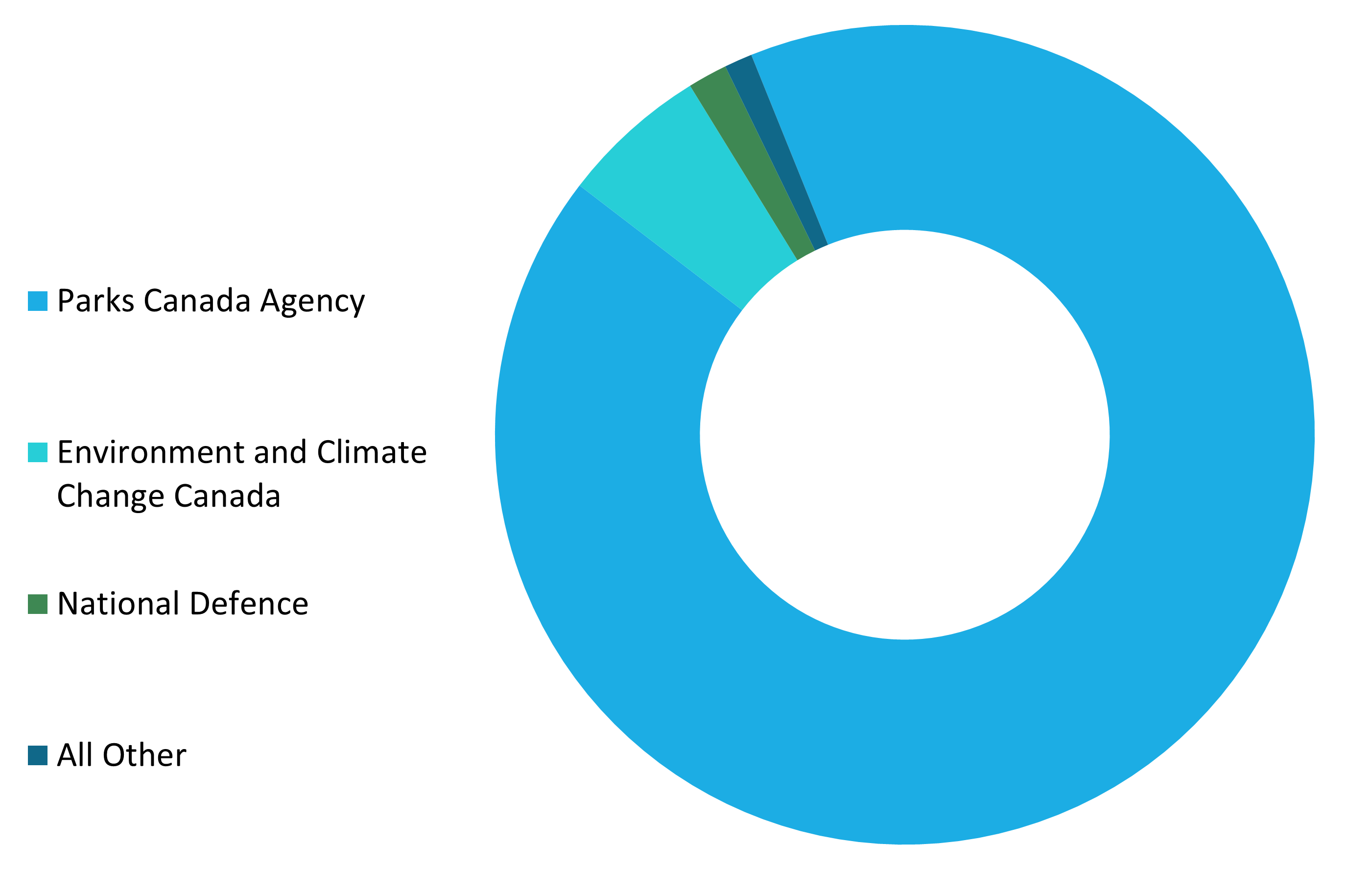
Text version
Pie chart displaying the percentage in Crown-owned land area by the top three reporting organizations. Parks Canada Agency occupies 92%, Environment and Climate Change Canada occupies 6%, National Defence occupies 2%, and all other organizations occupy 1%.
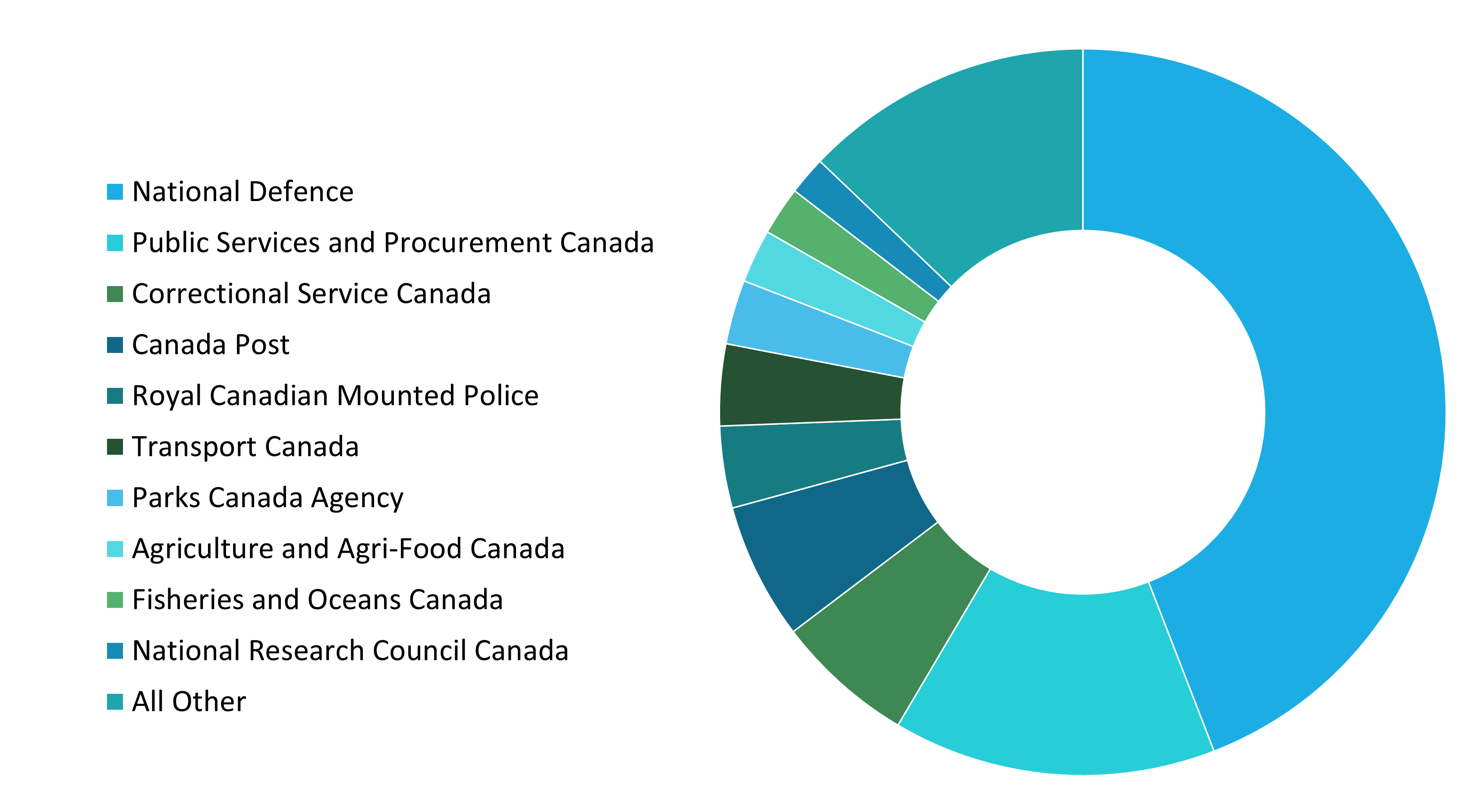
Text version
Pie chart displaying the percentage in Crown-owned floor space by the top ten reporting organizations.
National defence occupies 44%, Public Services and Procurement Canada occupies 14%, Correctional Service Canada occupies 6%, Canada Post occupies 6%, Royal Canadian Mounted Police occupies 4%, Transport Canada occupies 4%, Parks Canada Agency occupies 3%, Agriculture and Agri-Food Canada occupies 2%, Fisheries and Oceans Canada occupies 2%, National Research Council Canada occupies 2%, and all other organizations occupy 13%.
- Federal real property belongs to the Crown in right of Canada: administration entrusted to 16 departments, 22 agent Crown corporations and 16 port authorities
- 11,997 properties (39 million hectares) and 33,696 buildings (23.8 million square meters of space)
- Inventory includes office buildings, military bases, laboratories, light stations, penitentiaries, embassies, national parks, customs border crossings and infrastructure such as bridges and dams*
- Approximately 21% of Crown-owned buildings and 21% of floor space are in poor or critical condition
Note: Directory of Federal Real Property as of June 23, 2021. Data includes Crown
owned interest type for all reporting organizations.
Source: Treasury Board Secretariat
* Engineering assets are not reported in the Directory of Federal Real Property and thus are excluded from the graphs
presented above.
Sources of Greenhouse Gas Emissions, 2019-20
The Greening Government Strategy defines how the Government of Canada will transition to net-zero carbon and climate-resilient operations, while also reducing environmental impacts beyond carbon, including on waste, water and biodiversity.
4,671 kt* (Scope 3)**
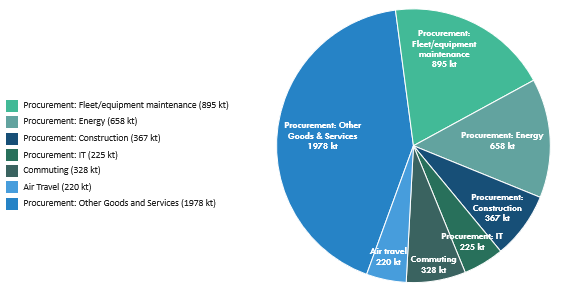
Text version
Pie chart describing sources of greenhouse gas emissions. Specifically, the estimated procurement of air travel and commuting. For a total of 4671 kilotons (Scope 3 - Indirect emissions), the pie chart breaks this down into seven categories.
Procurement: Fleet/equipment maintenance occupies 895 kilotons. Procurement: energy occupies 658 kilotons. Procurement: construction occupies 367 kilotons. Procurement: IT occupies 225 kilotons. Commuting occupies 328 kilotons.
Air travel occupies 220 kilotons. Procurement: other goods and services occupy 1978 kilotons.
*All numbers in kilotonnes (kt) of carbon dioxide equivalent. ** Scope 3 greenhouse gas emissions are
indirect emissions resulting from an organization’s operations.
Source: Treasury Board Secretariat, July 2021
As of fiscal year 2019-20, emissions from government-owned and leased buildings and conventional fleet have been reduced by 34.6% relative to 2005-06 levels, on track to meeting the 40% reduction by 2025 target.
1,177 kt* (Scope 1-2)**
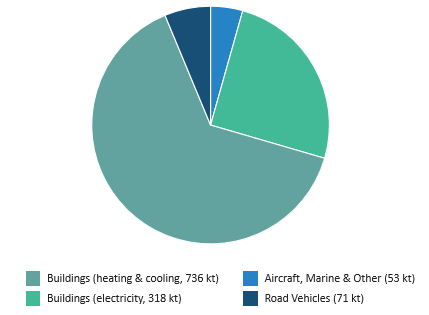
Text version
Pie chart describing buildings and conventional fleet. For a total of 1177 kilotons (Scope 1-2), the pie chart breaks this down into four categories. Buildings (heating and cooling) occupy 736 kilotons. Aircraft, marine, and other occupy 53 kilotons. Buildings (electricity) occupy 318 kilotons. Road vehicles occupy 71 kilotons.
951 kt (Scope 1)**
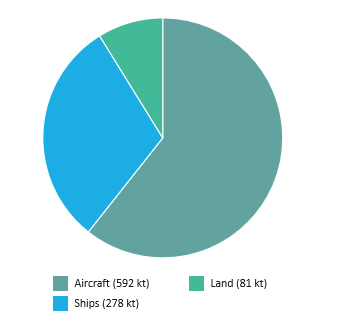
Text version
Pie chart describing national safety and security fleet. For a total of 951 kilotons (Scope 1), the pie chart breaks this down into three categories. Aircraft occupies 592 kilotons. Ships occupy 278 kilotons. Land occupies 81 kilotons.
*All numbers in kilotonnes (kt) of carbon dioxide equivalent.
** Scope 1 greenhouse gas emissions are those produced directly from sources that are owned or controlled by the
Government of Canada (for example, from the combustion of fuels in vehicles or in heating buildings). Scope 2
greenhouse gas emissions are those generated indirectly from the consumption of purchased energy (electricity, heating
and cooling).
Source: Treasury Board Secretariat, July 2021
Regulations
The Federal Regulatory System
- 400 Acts
with - 3K Regulations*
- 55
departments and agencies have regulatory responsibilities
- 34K Full Time
Equivalents
perform regulatory functions
- 150-200 Proposals
for new or amended regulations and - 200-300 Proposals
for Orders in Council are reviewed and approved annually by Treasury Board
*includes all statutory orders and regulations (Governor in Council, Ministerial and independent)
Source: Treasury Board Secretariat, June 2021